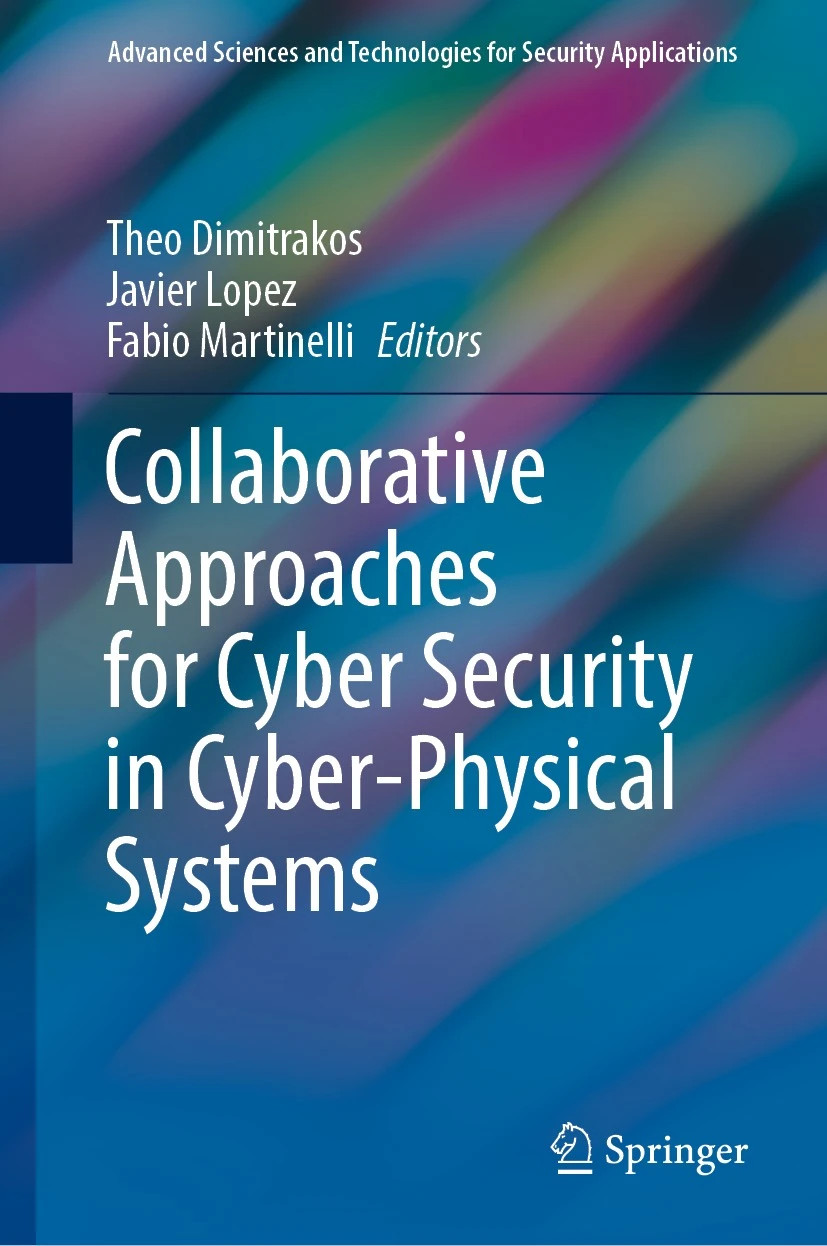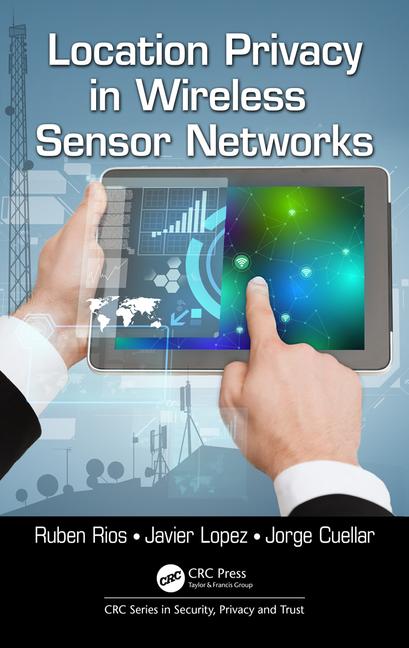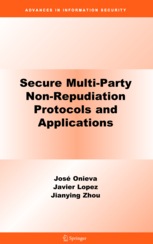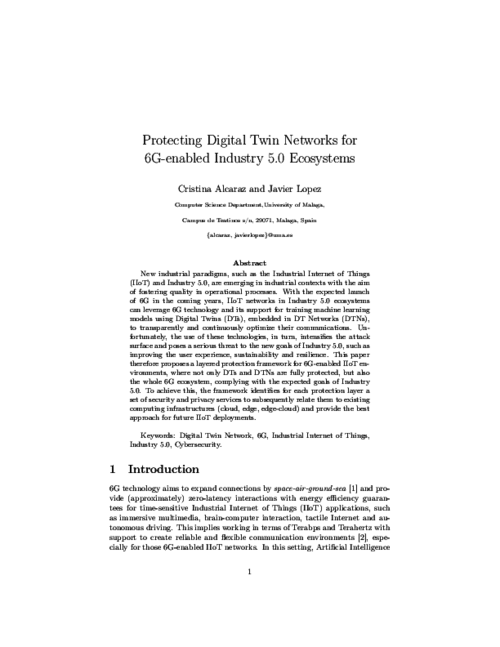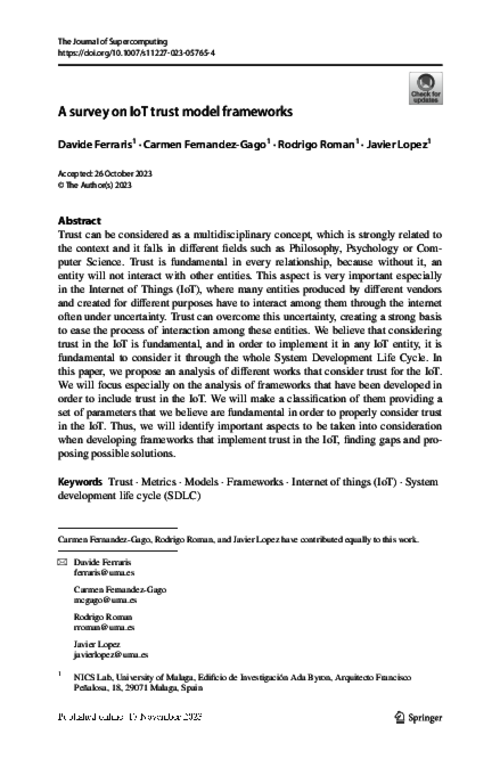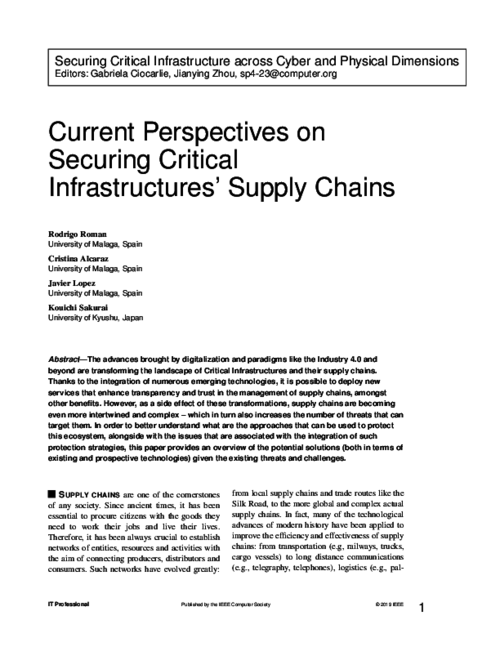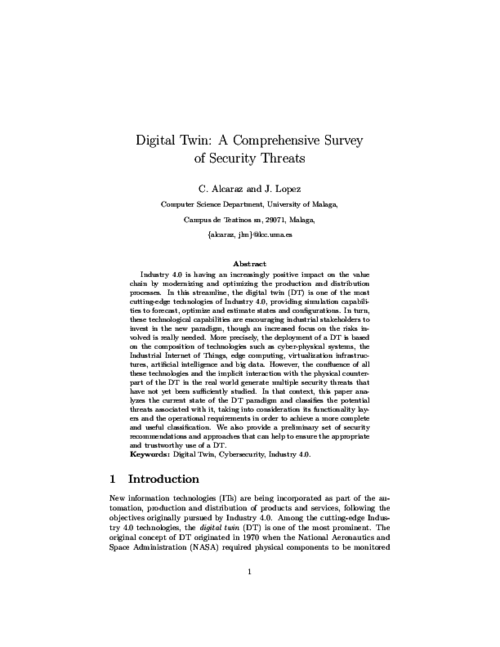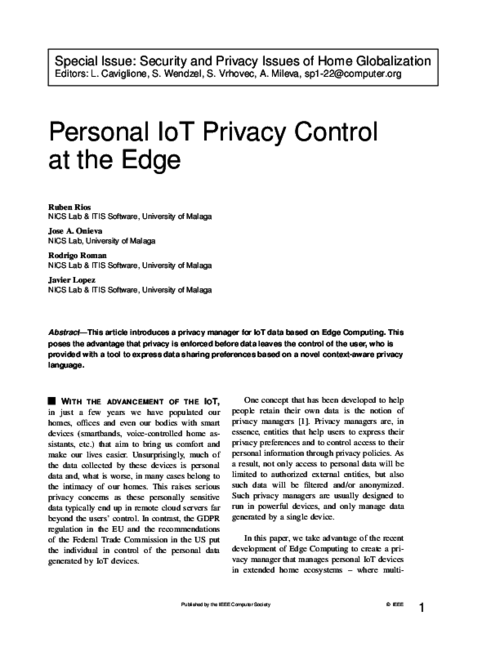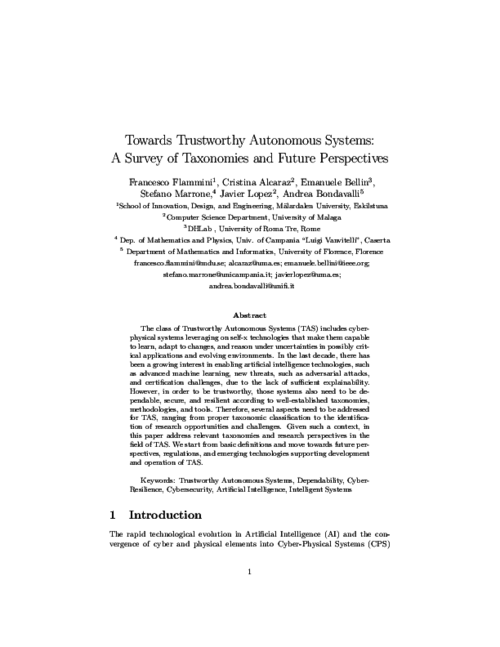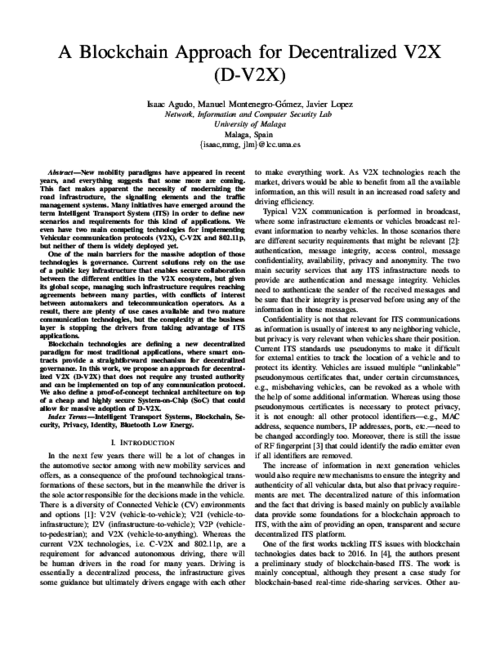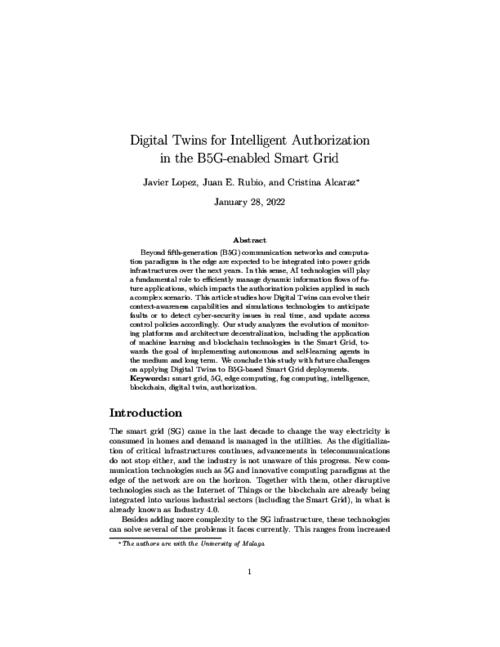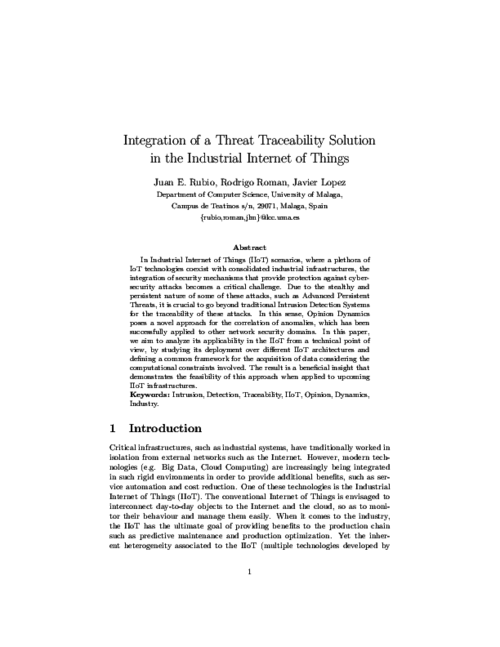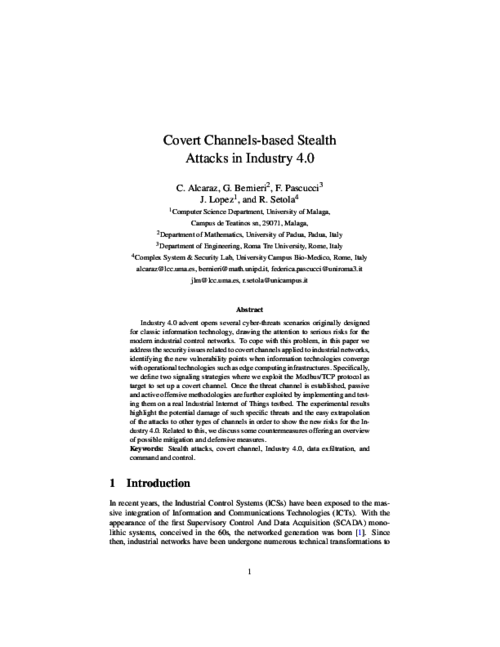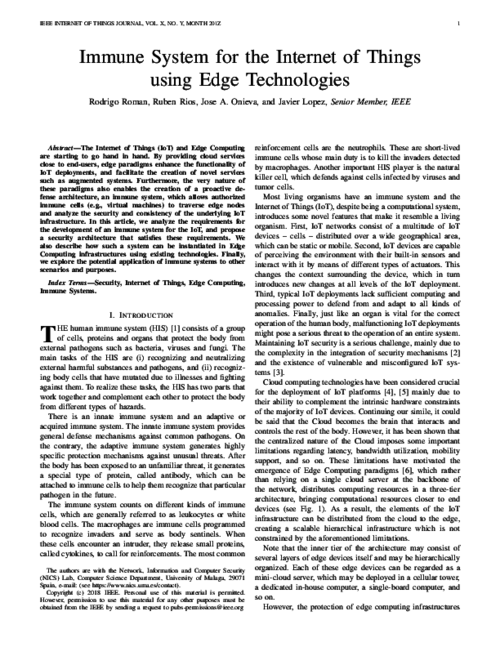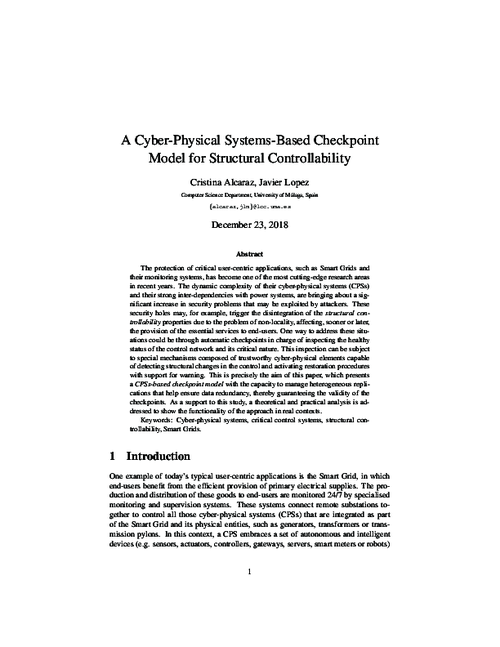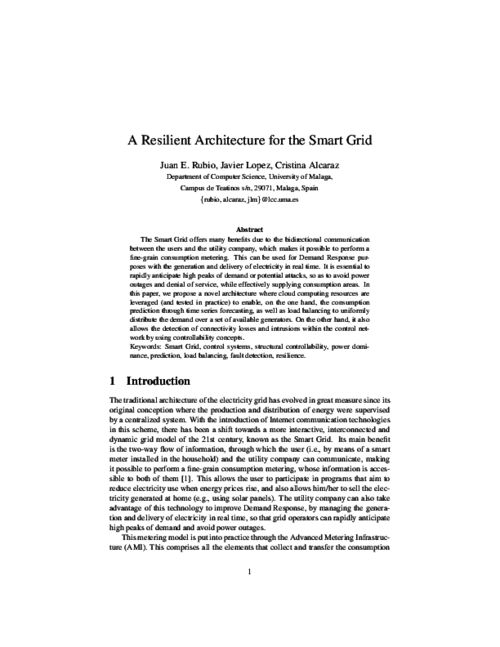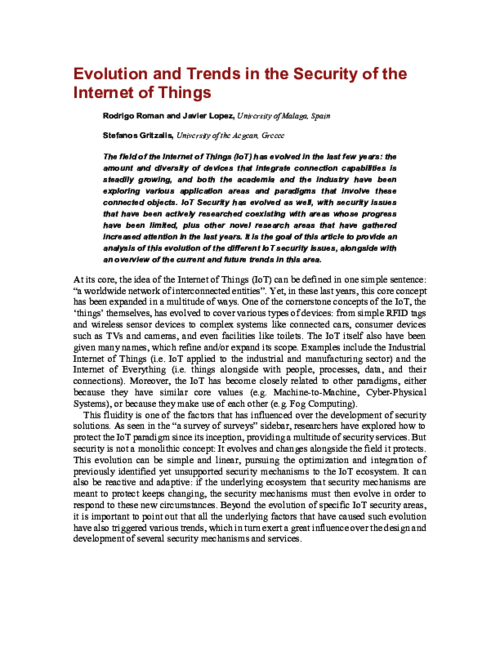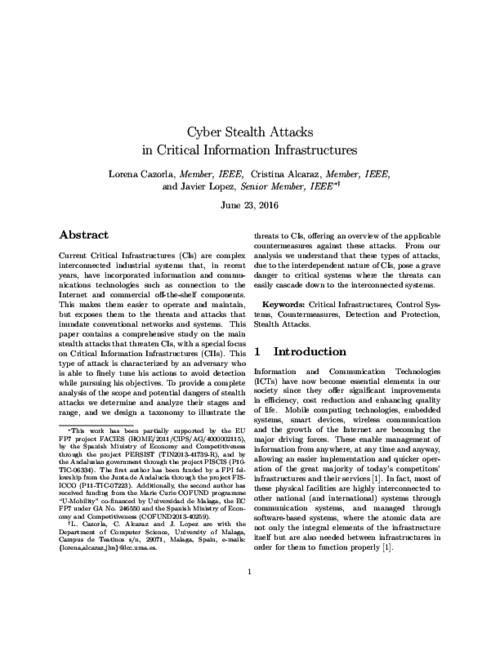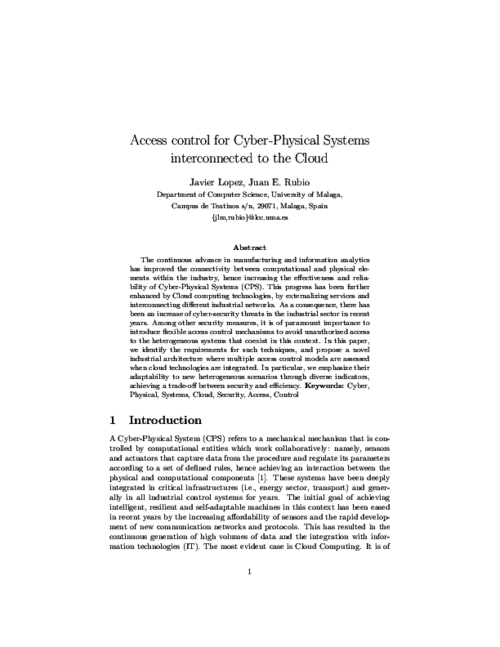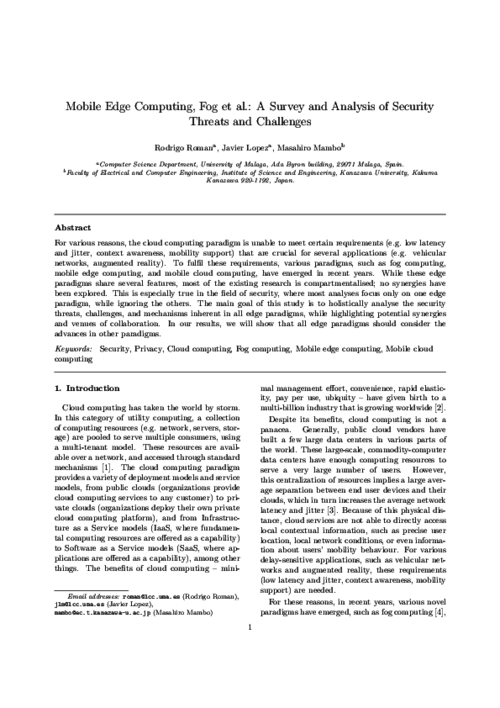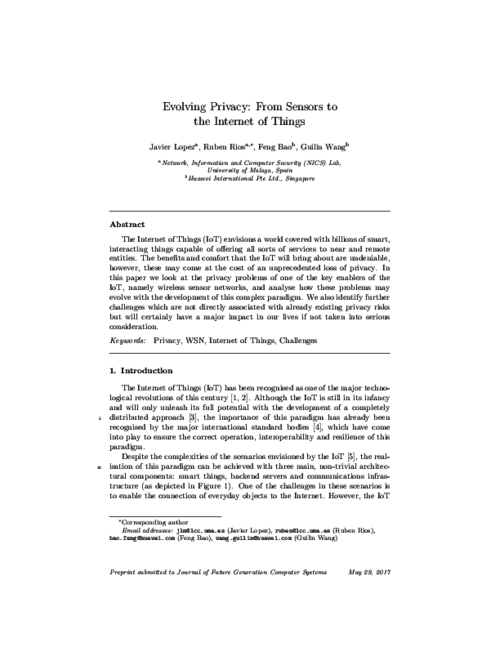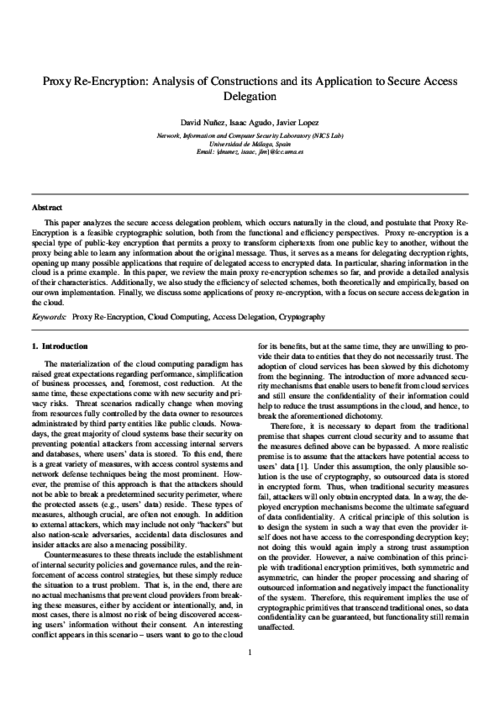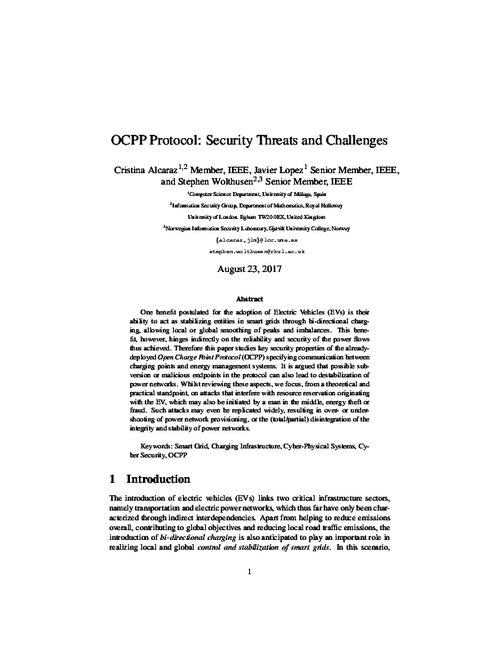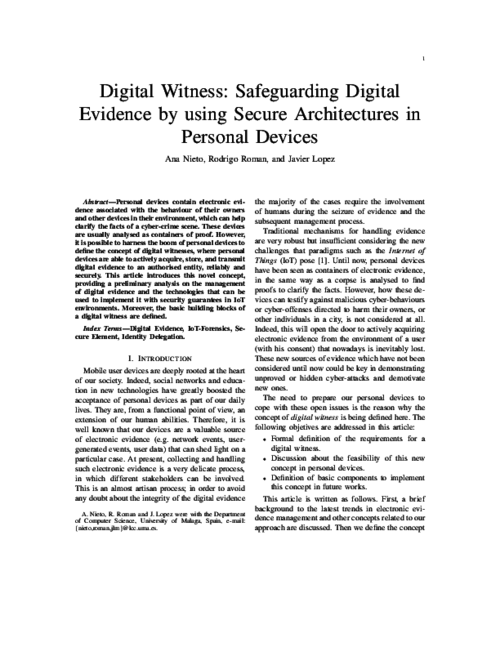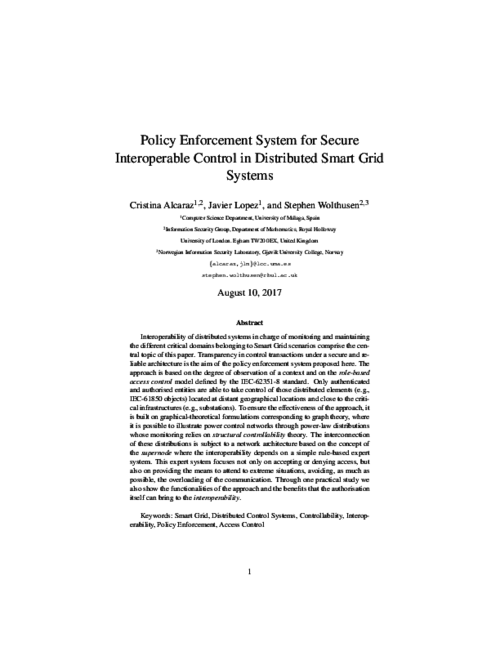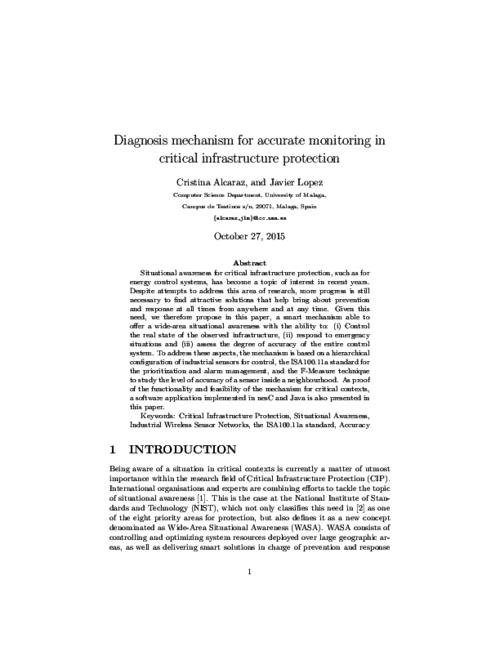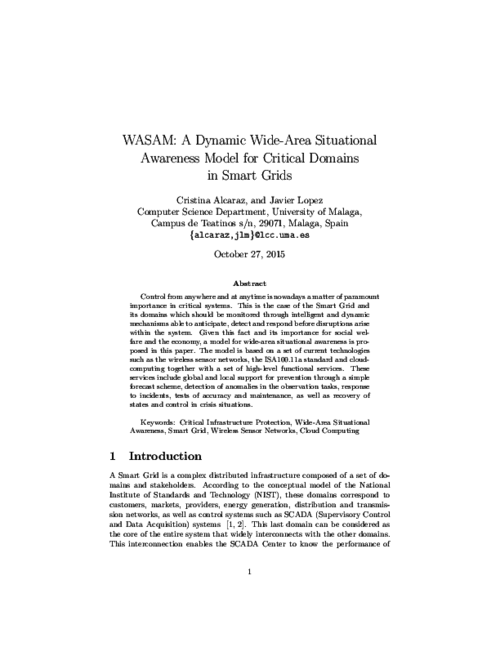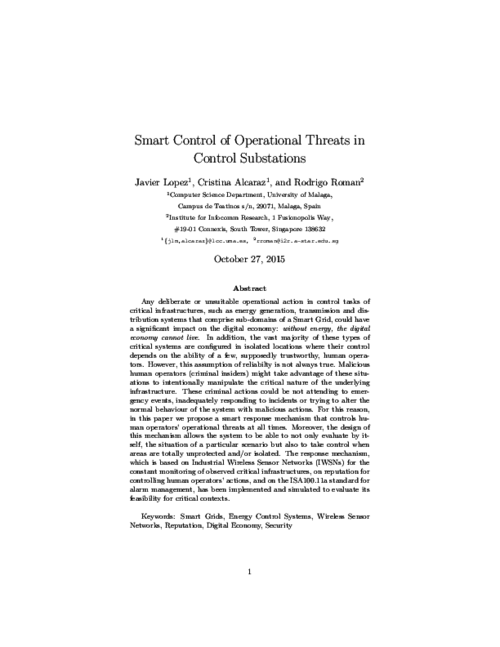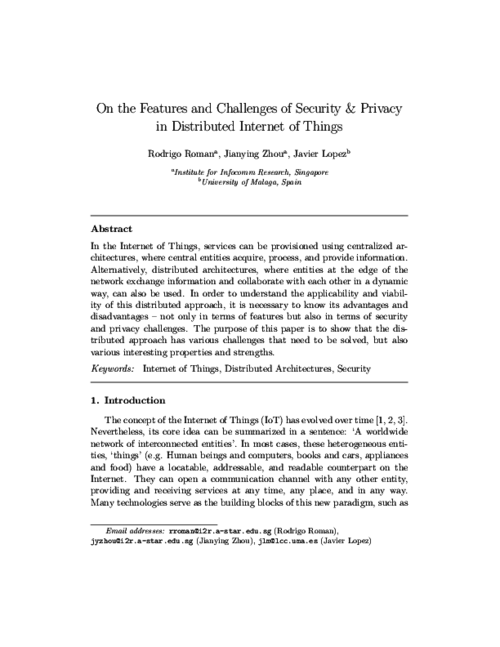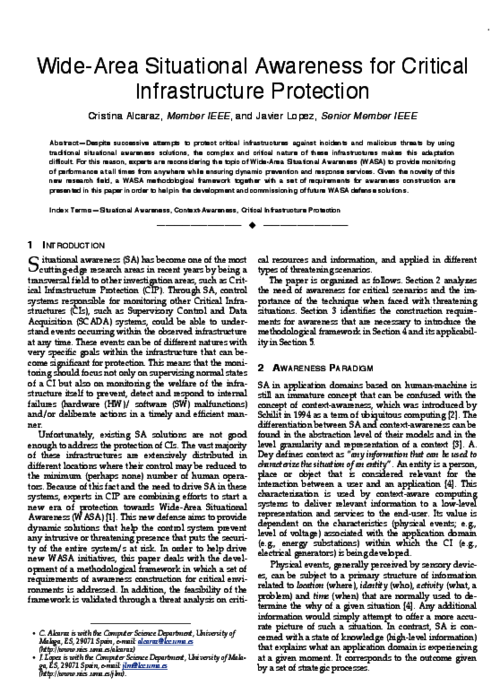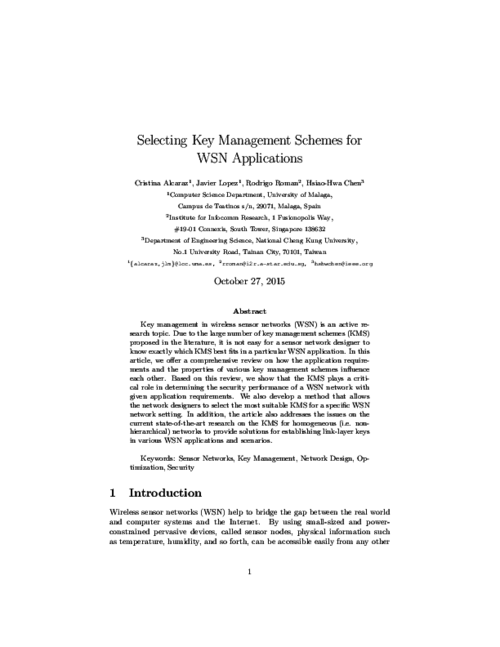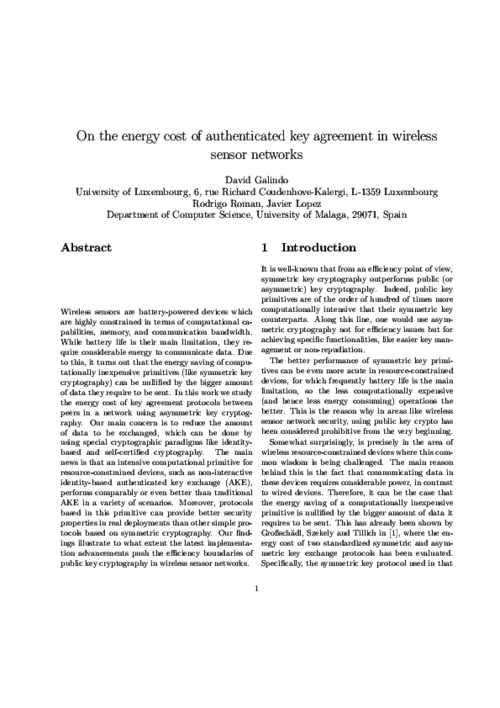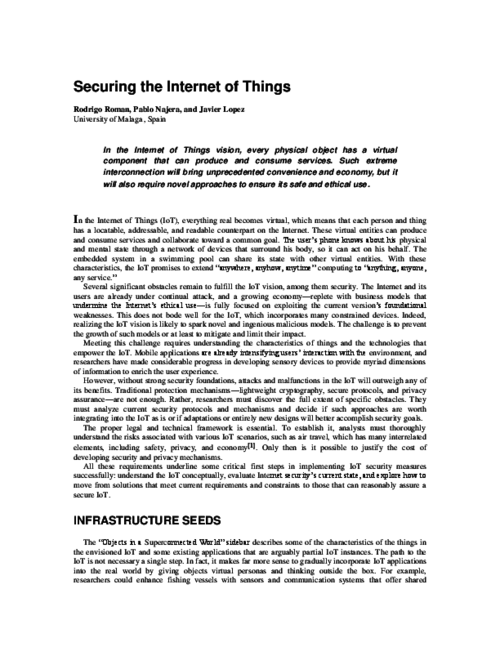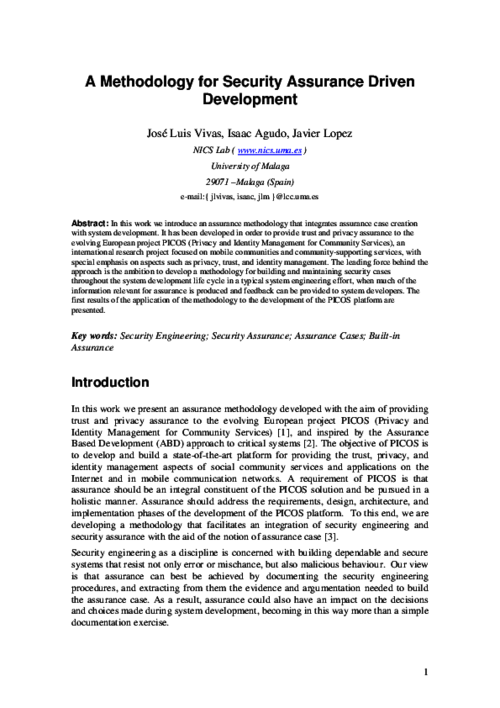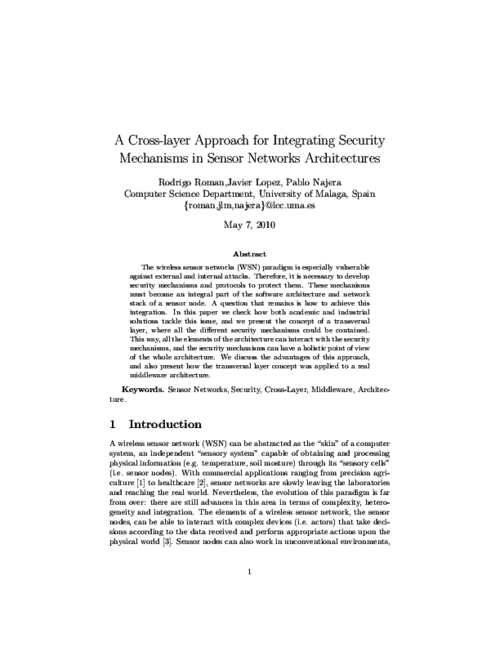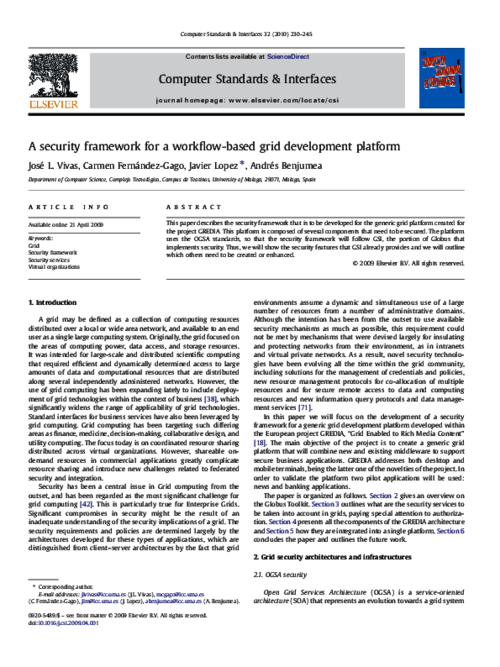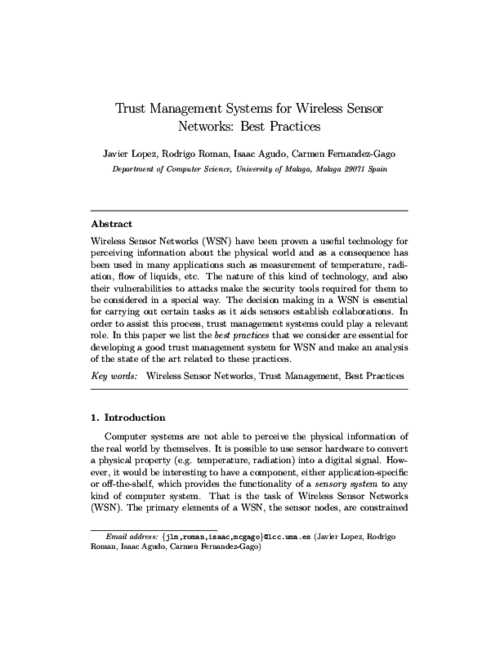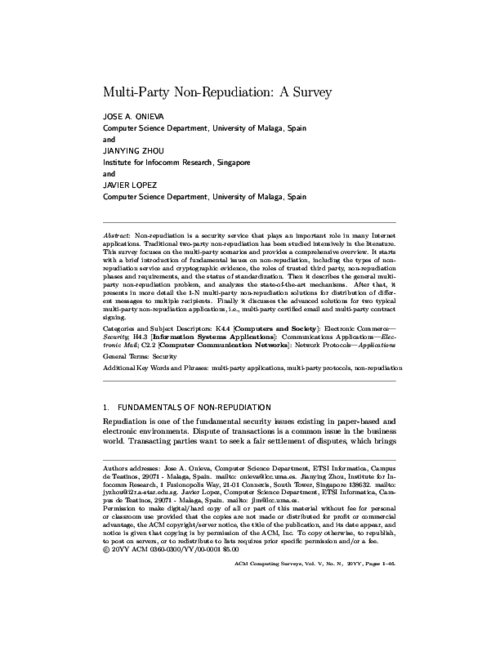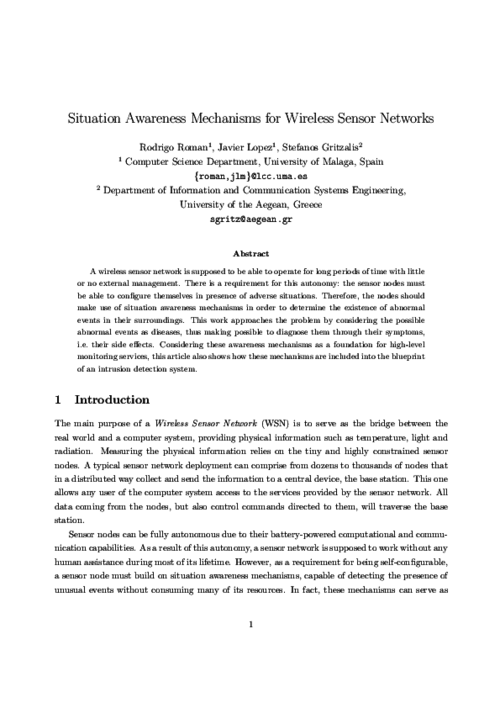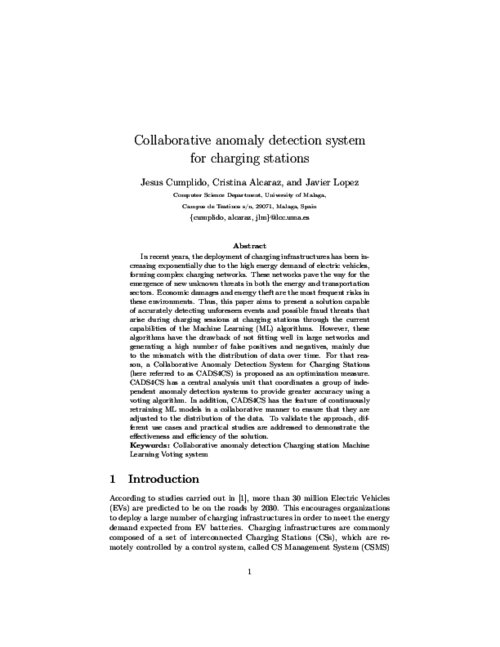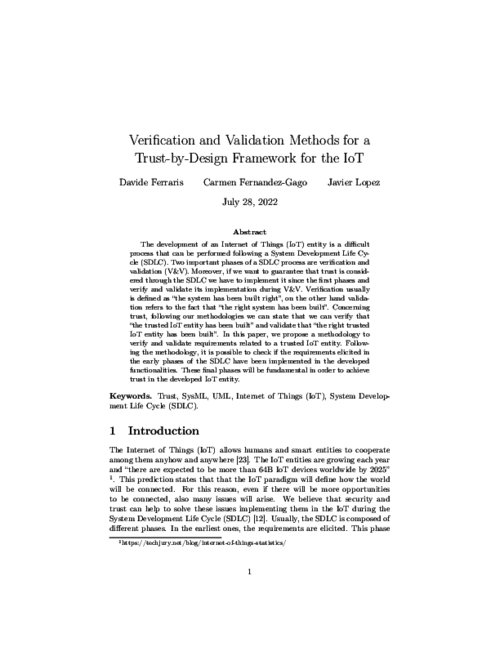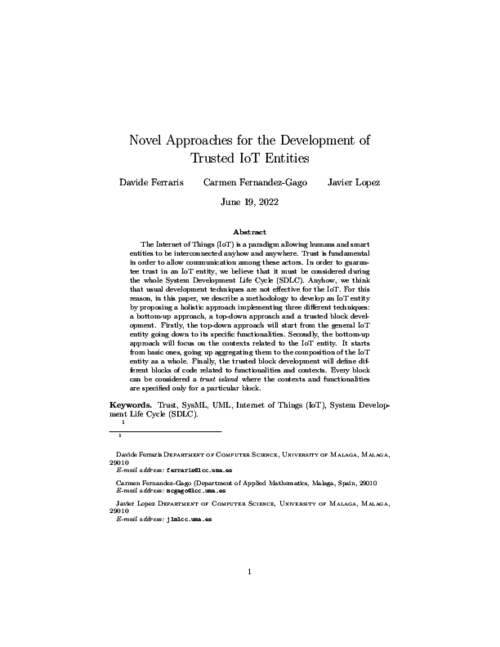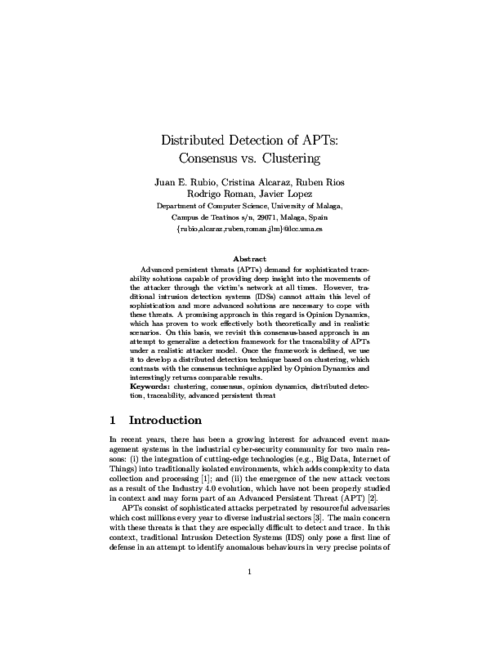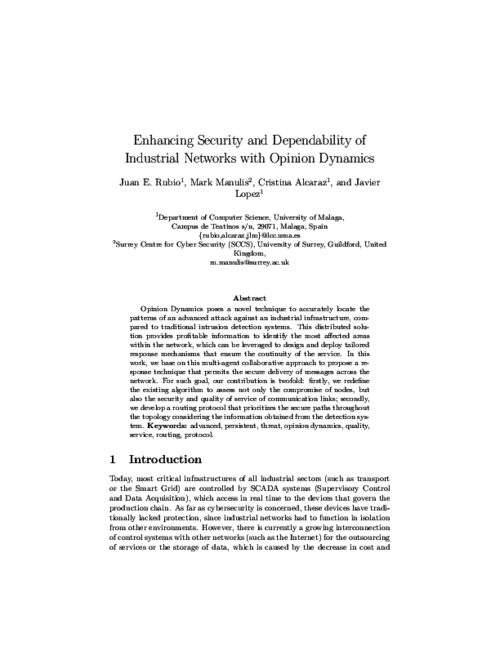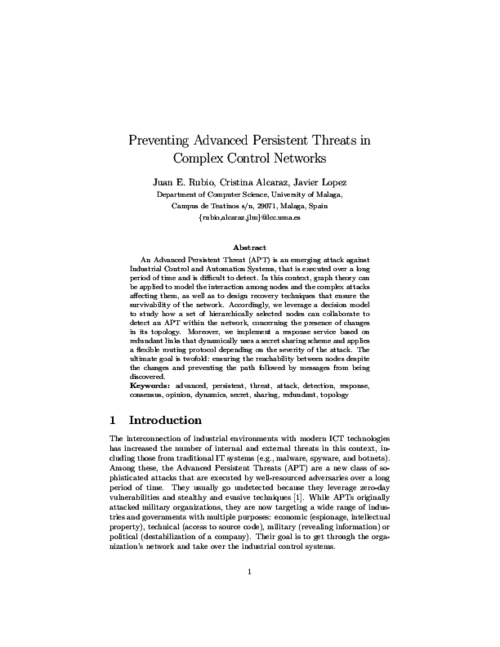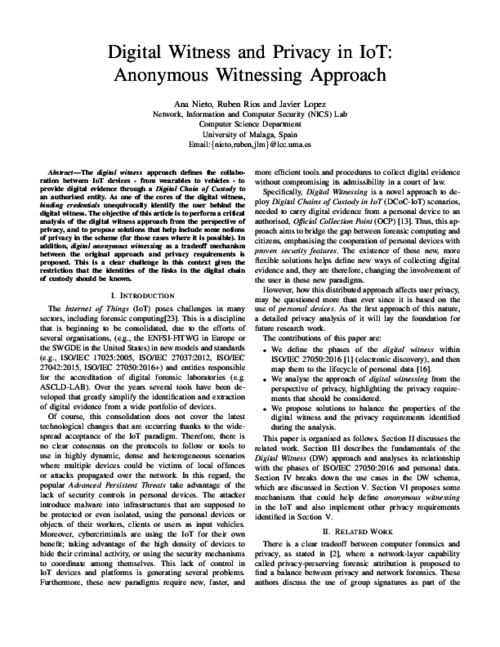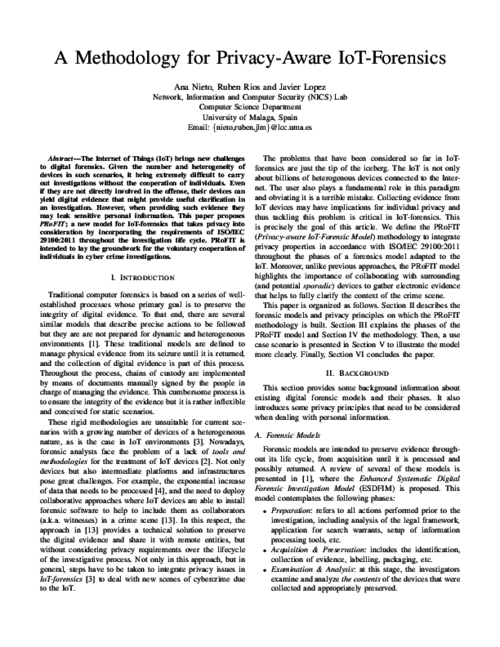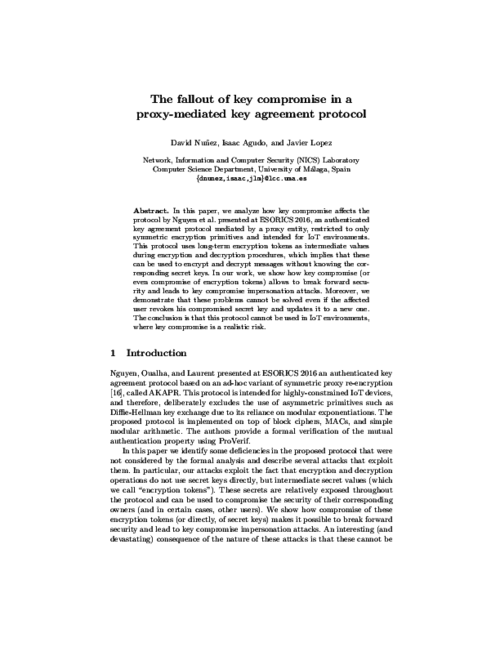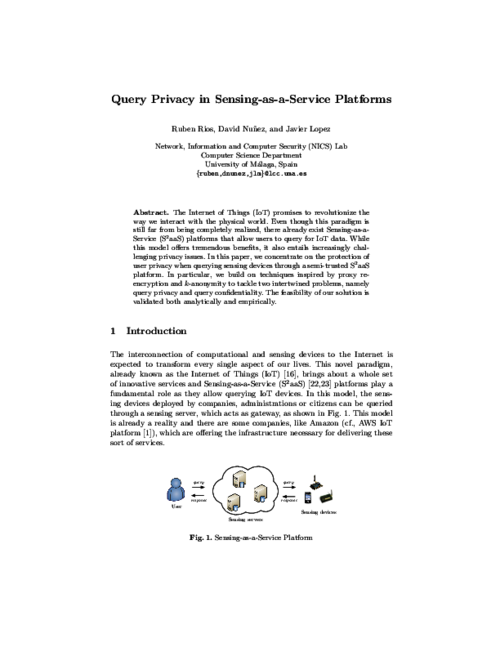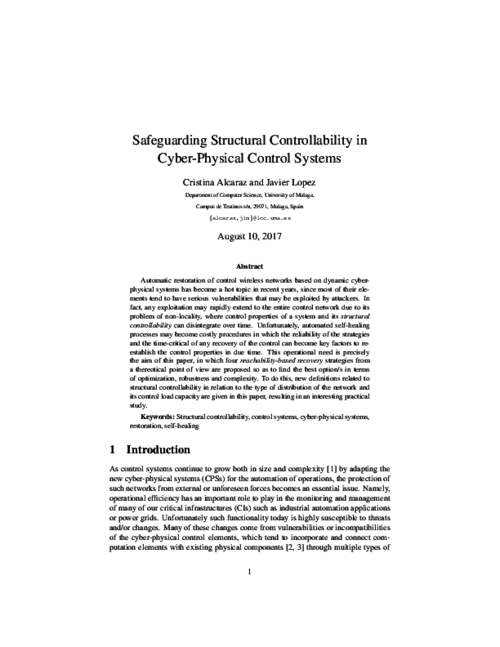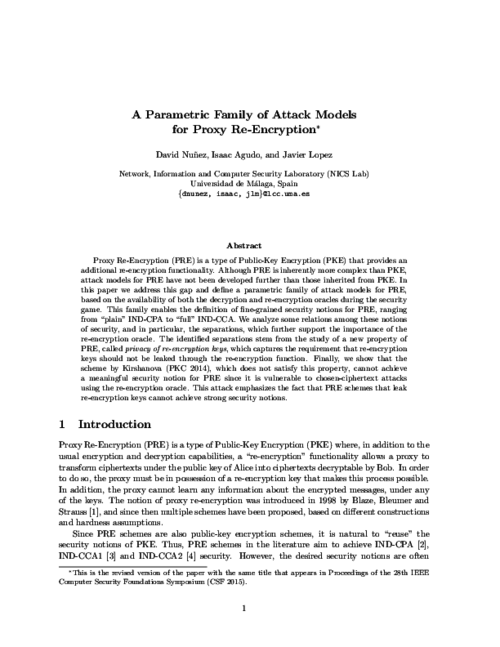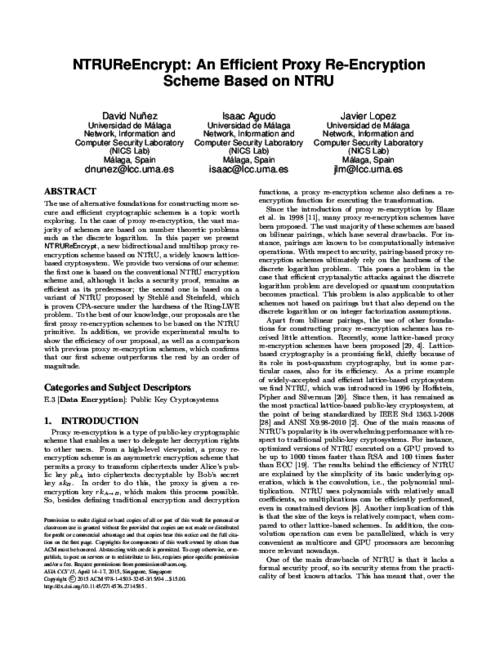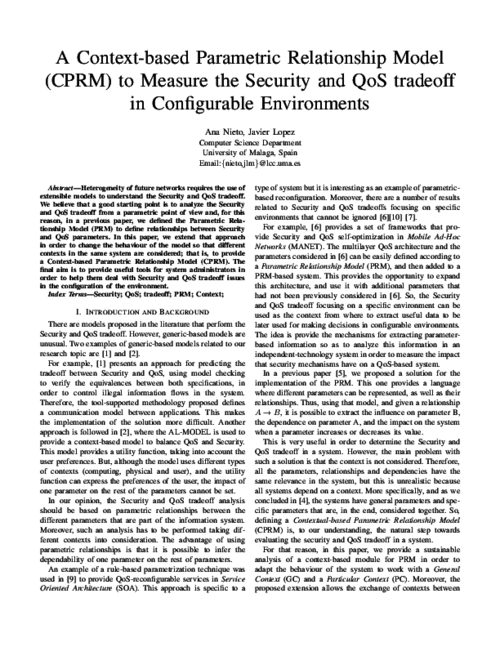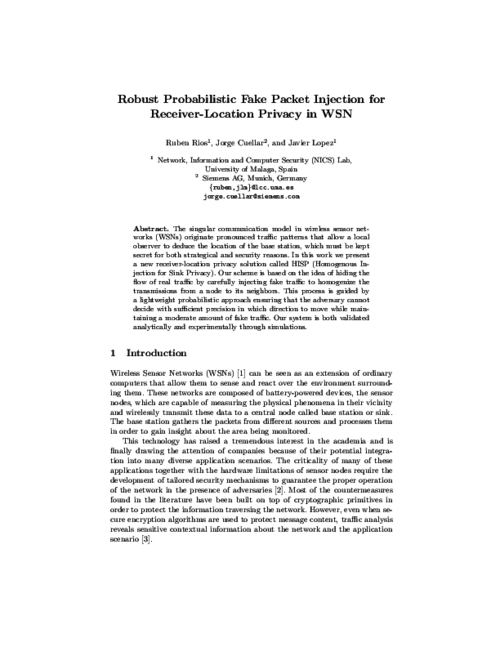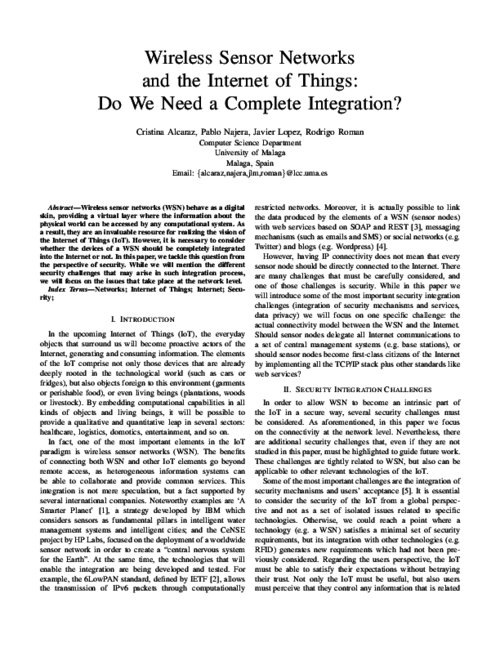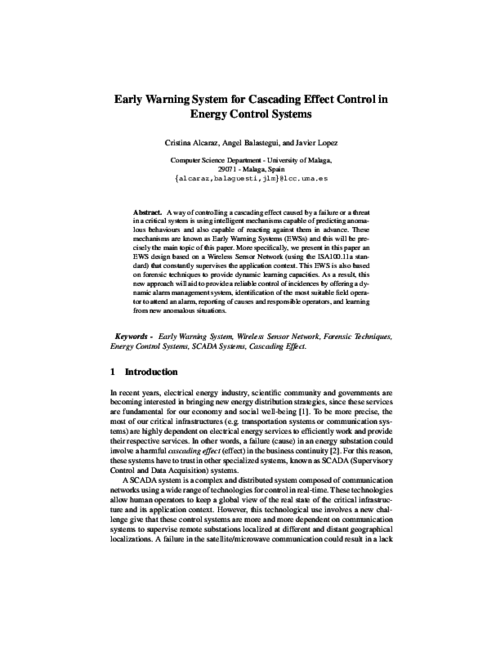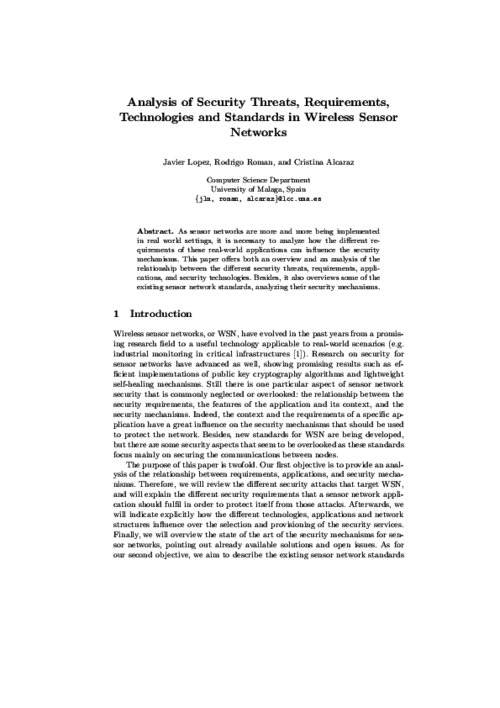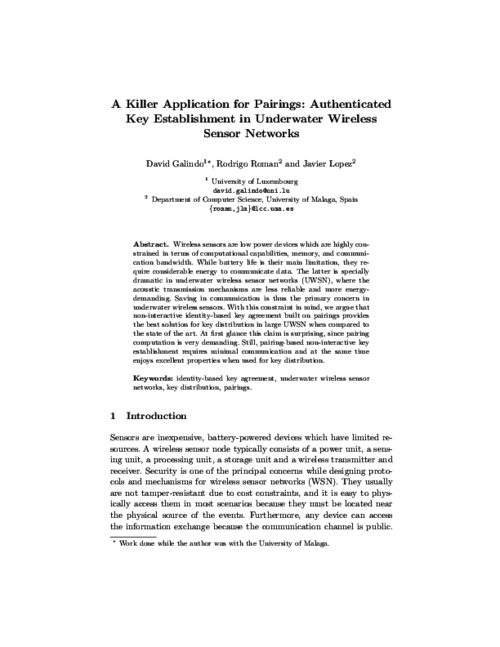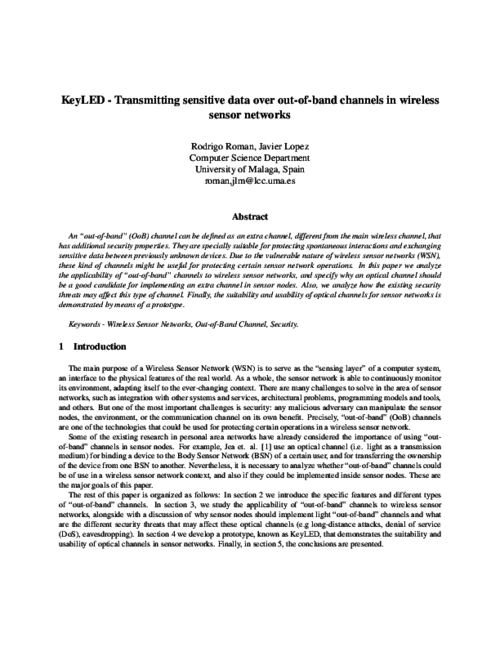Javier López
Full Professor (Catedrático)
Computer Science Department, University of Malaga
Campus de Teatinos s/n, 29071 – Malaga (Spain)
Phone: +34 952 131 327 | Fax: +34 952 131 397
E-mail: javierlopez@uma.es
Scientific Activities
- Editorial Board member:
- IEEE Wireless Communications, IEEE
- Journal of Network and Computer Applications, Elsevier
- Advances in Information Security (book series), Springer
- Human-centric Computing and Information Sciences, KCIA
- SpringerBriefs on Cyber Security Systems and Networks (book series), Springer
- Information and Computer Security Journal, Emerald
- International Journal of Internet Technology and Secured Transactions, Inderscience Publishers
- Cryptology & Information Security (book series), IOS Press
- International Journal on Critical Infrastructure Protection, Elsevier (2008-2016)
- Security and Communications Network, John Wiley & Sons (2008-2016)
- Computer Communications, Elsevier (2009-2012)
- Wireless Communications and Mobile Computing, John Wiley & Sons (2008-2011)
- Computer Networks, Elsevier (2008-2011)
- IEEE Internet of Things Journal, IEEE (2013-2019)
- IET Information Security, IET (2010-2020)
- International Journal of Communication Systems, John Wiley & Sons (2009-2020)
- Journal of Computer Security, IOS Press (2013-2022)
- IEEE Transactions on Dependable and Secure Computing, IEEE (2019-2023)
- Computers & Security, Elsevier (2009-2023)
- Security and Privacy, John Wiley & Sons (2017-2024)
- Vice-Chair, IFIP Technical Committee 11: Security and Privacy Protection in Information Processing Systems
- IEEE Senior Member
- ACM Senior Member
- Co-Editor in Chief, International Journal of Information Security (IJIS), Springer (2004-2021)
- Spanish representative in IFIP Technical Committee 11 – Security and Privacy Protection in Information Processing Systems (2003-2018)
- Member of the Spanish Mirror Committee JTC1 of ISO
- Chair, ERCIM Working Group on Security and Trust Management (ERCIM-STM) (2009-2012)
- Chair, IFIP Working Group 11.11 on Trust Management (2006-2009)
- President of RENIC – Spanish Network of Excellence on Cybersecurity Research (2018-2022)
PhD Thesis (co)Advisor
- Davide Ferraris (2022)
- Martín Kolar (2022)
- Juan E. Rubio (2022)
- Giuseppe Bernieri (2018)
- Lorena Cazorla (2017)
- David Núñez (2016)
- Francisco Moyano (2015)
- Ana Nieto (2015)
- Rubén Ríos (2014)
- Pablo Nájera (2013)
- Cristina Alcaraz (2011)
- David Garcia (2009)
- Isaac Agudo (2008)
- Rodrigo Roman (2008)
- Vicente Benjumea (2007)
- Jose A. Onieva (2006)
- Jose A. Montenegro (2006)
- Juan J. Ortega (2005)
- Antonio Maña (2003)
Most recent or referenced publications
BOOKS:
Theo Dimitrakos, Javier Lopez, Fabio Martinelli
Collaborative Approaches for Cyber Security in Cyber-Physical Systems Book
Springer, 2023, ISBN: 9783031160882.
BibTeX | Links:
@book{Lopez2023,
title = {Collaborative Approaches for Cyber Security in Cyber-Physical Systems},
author = {Theo Dimitrakos and Javier Lopez and Fabio Martinelli},
url = {https://link.springer.com/book/10.1007/978-3-031-16088-2},
doi = {10.1007/978-3-031-16088-2},
isbn = {9783031160882},
year = {2023},
date = {2023-01-02},
urldate = {2023-01-02},
publisher = {Springer},
keywords = {},
pubstate = {published},
tppubtype = {book}
}
Ruben Rios, Javier Lopez, Jorge Cuellar
Location Privacy in Wireless Sensor Networks Book
Taylor & Francis, 2016, ISBN: 9781498776332.
BibTeX | Links:
@book{Rios2016,
title = {Location Privacy in Wireless Sensor Networks},
author = {Ruben Rios and Javier Lopez and Jorge Cuellar},
url = {https://www.crcpress.com/Location-Privacy-in-Wireless-Sensor-Networks/Rios-Lopez-Cuellar/p/book/9781498776332},
isbn = {9781498776332},
year = {2016},
date = {2016-01-01},
urldate = {2016-01-01},
publisher = {Taylor \& Francis},
organization = {Taylor \& Francis},
series = {CRC Series in Security, Privacy and Trust},
keywords = {},
pubstate = {published},
tppubtype = {book}
}
Maritta Heisel, Wouter Joosen, Javier Lopez, Fabio Martinelli
Engineering Secure Future Internet Services and Systems- Current Research Book
Springer, 2014.
@book{1483,
title = {Engineering Secure Future Internet Services and Systems- Current Research},
author = {Maritta Heisel and Wouter Joosen and Javier Lopez and Fabio Martinelli},
year = {2014},
date = {2014-01-01},
urldate = {2014-01-01},
volume = {8431},
publisher = {Springer},
organization = {Springer},
series = {Lecture Notes in Computer Science},
abstract = {This State-of-the-Art Survey contains a selection of papers representing state-of-the-art results in the engineering of secure software-based Future Internet services and systems, produced by the NESSoS project researchers. The engineering approach of the Network of Excellence NESSoS, funded by the European Commission, is based on the principle of addressing security concerns from the very beginning in all software development phases, thus contributing to reduce the amount of software vulnerabilities and enabling the systematic treatment of security needs through the engineering process. The 15 papers included in this volume deal with the main NESSoS research areas: security requirements for Future Internet services; creating secure service architectures and secure service design; supporting programming environments for secure and composable services; enabling security assurance and integrating former results in a risk-aware and cost-aware software life-cycle.},
keywords = {},
pubstate = {published},
tppubtype = {book}
}
Javier Lopez, Roberto Setola, Stephen Wolthusen (Ed.)
Advances in Critical Infrastructure Protection: Information Infrastructure Models, Analysis, and Defense Book
Springer, 2012, ISSN: 978-3-642-28919-4.
@book{1696,
title = {Advances in Critical Infrastructure Protection: Information Infrastructure Models, Analysis, and Defense},
editor = {Javier Lopez and Roberto Setola and Stephen Wolthusen},
issn = {978-3-642-28919-4},
year = {2012},
date = {2012-01-01},
urldate = {2012-01-01},
volume = {6715},
publisher = {Springer},
organization = {Springer},
series = {LNCS},
keywords = {},
pubstate = {published},
tppubtype = {book}
}
Jose A. Onieva, Javier Lopez, Jianying Zhou
Secure Multi-Party Non-Repudiation Protocols and Applications Book
Springer, 2009, ISBN: 978-0-387-75629-5.
BibTeX | Links:
@book{Onieva2009,
title = {Secure Multi-Party Non-Repudiation Protocols and Applications},
author = {Jose A. Onieva and Javier Lopez and Jianying Zhou},
url = {http://www.springer.com/computer/security+and+cryptology/book/978-0-387-75629-5},
doi = {10.1007/978-0-387-75630-1},
isbn = {978-0-387-75629-5},
year = {2009},
date = {2009-01-01},
urldate = {2009-01-01},
volume = {43},
publisher = {Springer},
organization = {Springer},
series = {Advances in Information Security},
keywords = {},
pubstate = {published},
tppubtype = {book}
}
JOURNALS:

Cristina Alcaraz, Javier Lopez
Digital Twin-assisted anomaly detection for industrial scenarios Journal Article
In: International Journal of Critical Infrastructure Protection, vol. 47, pp. 100721, 2024, ISSN: 1874-5482.
@article{Alcaraz2024c,
title = {Digital Twin-assisted anomaly detection for industrial scenarios},
author = {Cristina Alcaraz and Javier Lopez},
url = {https://www.sciencedirect.com/science/article/pii/S1874548224000623},
doi = {https://doi.org/10.1016/j.ijcip.2024.100721},
issn = {1874-5482},
year = {2024},
date = {2024-12-01},
urldate = {2024-12-01},
journal = {International Journal of Critical Infrastructure Protection},
volume = {47},
pages = {100721},
abstract = {Industry 5.0 is the current industrial paradigm that inherits the technological diversity of its predecessor, Industry 4.0, but includes three priority goals: (i) resilience, (ii) sustainability and (iii) human-centeredness. Through these three goals, Industry 5.0 pursues a more far-reaching digital transformation in industrial ecosystems with high protection guarantees. However, the deployment of innovative information technologies for this new digital transformation also requires considering their implicit vulnerabilities and threats in order to avoid any negative impacts on the three Industry 5.0 goals, and to prioritize cybersecurity aspects so as to ensure acceptable protection levels. This paper, therefore, proposes a detection framework composed of a Digital Twin (DT) and machine learning algorithms for online protection, supporting the resilience that Industry 5.0 seeks. To validate the approach, this work includes several practical studies on a real industrial control testbed to demonstrate the feasibility and accuracy of the framework, taking into account a set of malicious perturbations in several critical sections of the system. The results highlight the effectiveness of the DT in complementing the anomaly detection processes, especially for advanced and stealthy threats.},
keywords = {},
pubstate = {published},
tppubtype = {article}
}
Cristina Alcaraz, Javier Lopez
Protecting Digital Twin Networks for 6G-enabled Industry 5.0 Ecosystems Journal Article
In: IEEE Network Magazine, vol. 37, no. 2, pp. 302-308, 2023, ISSN: 0890-8044.
@article{Alcaraz2023a,
title = {Protecting Digital Twin Networks for 6G-enabled Industry 5.0 Ecosystems},
author = {Cristina Alcaraz and Javier Lopez},
url = {/wp-content/papers/Alcaraz2023a.pdf
https://ieeexplore.ieee.org/abstract/document/10239369},
doi = {10.1109/MNET.004.2200529},
issn = {0890-8044},
year = {2023},
date = {2023-12-31},
urldate = {2023-12-31},
journal = {IEEE Network Magazine},
volume = {37},
number = {2},
pages = {302-308},
publisher = {IEEE},
abstract = {New industrial paradigms, such as the Industrial Internet of Things (IIoT) and Industry 5.0, are emerging in industrial contexts with the aim of fostering quality in operational processes. With the expected launch of 6G in the coming years, IIoT networks in Industry 5.0 ecosystems can leverage 6G technology and its support for training machine learning models using Digital Twins (DTs), embedded in DT Networks (DTNs), to transparently and continuously optimize their communications. Unfortunately, the use of these technologies, in turn, intensifies the attack surface and poses a serious threat to the new goals of Industry 5.0, such as improving the user experience, sustainability and resilience. This article therefore proposes a layered protection framework for 6G-enabled IIoT environments, where not only DTs and DTNs are fully protected, but also the whole 6G ecosystem, complying with the expected goals of Industry 5.0. To achieve this, the framework identifies for each protection layer a set of security and privacy services to subsequently relate them to existing computing infrastructures (cloud, edge, edge-cloud) and provide the best approach for future IIoT deployments.},
keywords = {},
pubstate = {published},
tppubtype = {article}
}
Davide Ferraris, Carmen Fernandez-Gago, Rodrigo Roman, Javier Lopez
A Survey on IoT Trust Model Frameworks Journal Article
In: The Journal of Supercomputing, vol. 80, pp. 8259–8296, 2023.
@article{surveyIoTrust2023,
title = {A Survey on IoT Trust Model Frameworks},
author = {Davide Ferraris and Carmen Fernandez-Gago and Rodrigo Roman and Javier Lopez},
url = {/wp-content/papers/surveyIoTrust2023.pdf},
doi = {10.1007/s11227-023-05765-4},
year = {2023},
date = {2023-11-17},
urldate = {2023-11-17},
journal = {The Journal of Supercomputing},
volume = {80},
pages = {8259\textendash8296},
abstract = {Trust can be considered as a multidisciplinary concept, which is strongly related to the context and it falls in different fields such as Philosophy, Psychology or Computer Science. Trust is fundamental in every relationship, because without it, an entity will not interact with other entities. This aspect is very important especially in the Internet of Things (IoT), where many entities produced by different vendors and created for different purposes have to interact among them through the internet often under uncertainty. Trust can overcome this uncertainty, creating a strong basis to ease the process of interaction among these entities. We believe that considering trust in the IoT is fundamental, and in order to implement it in any IoT entity, it is fundamental to consider it through the whole System Development Life Cycle. In this paper, we propose an analysis of different works that consider trust for the IoT. We will focus especially on the analysis of frameworks that have been developed in order to include trust in the IoT. We will make a classification of them providing a set of parameters that we believe are fundamental in order to properly consider trust in the IoT. Thus, we will identify important aspects to be taken into consideration when developing frameworks that implement trust in the IoT, finding gaps and proposing possible solutions.},
keywords = {},
pubstate = {published},
tppubtype = {article}
}
Rodrigo Roman, Cristina Alcaraz, Javier Lopez, Kouichi Sakurai
Current Perspectives on Securing Critical Infrastructures’ Supply Chains Journal Article
In: IEEE Security & Privacy, vol. 21, no. 4, pp. 29-38, 2023, ISSN: 1540-7993.
BibTeX | Links:
@article{Roman2023a,
title = {Current Perspectives on Securing Critical Infrastructures’ Supply Chains},
author = {Rodrigo Roman and Cristina Alcaraz and Javier Lopez and Kouichi Sakurai},
url = {/wp-content/papers/Roman2023a.pdf},
doi = {10.1109/MSEC.2023.3247946},
issn = {1540-7993},
year = {2023},
date = {2023-03-08},
urldate = {2023-03-08},
journal = {IEEE Security \& Privacy},
volume = {21},
number = {4},
pages = {29-38},
publisher = {IEEE},
keywords = {},
pubstate = {published},
tppubtype = {article}
}
Cristina Alcaraz, Javier Lopez
Digital Twin: A Comprehensive Survey of Security Threats Journal Article
In: IEEE Communications Surveys & Tutorials, vol. 24, no. thirdquarter 2022, pp. 1475 – 1503, 2022, ISSN: 1553-877X.
@article{Alcaraz2022b,
title = {Digital Twin: A Comprehensive Survey of Security Threats},
author = {Cristina Alcaraz and Javier Lopez},
url = {/wp-content/papers/Alcaraz2022b.pdf
https://ieeexplore.ieee.org/document/9765576},
doi = {10.1109/COMST.2022.3171465},
issn = {1553-877X},
year = {2022},
date = {2022-04-01},
urldate = {2022-04-01},
journal = {IEEE Communications Surveys \& Tutorials},
volume = {24},
number = {thirdquarter 2022},
pages = {1475 - 1503},
publisher = {IEEE},
address = {IEEE},
abstract = {Industry 4.0 is having an increasingly positive impact on the value chain by modernizing and optimizing the production and distribution processes. In this streamline, the digital twin (DT) is one of the most cutting-edge technologies of Industry 4.0, providing simulation capabilities to forecast, optimize and estimate states and configurations. In turn, these technological capabilities are encouraging industrial stakeholders to invest in the new paradigm, though an increased focus on the risks involved is really needed. More precisely, the deployment of a DT is based on the composition of technologies such as cyber-physical systems, the Industrial Internet of Things, edge computing, virtualization infrastructures, artificial intelligence and big data. However, the confluence of all these technologies and the implicit interaction with the physical counterpart of the DT in the real world generate multiple security threats that have not yet been sufficiently studied. In that context, this paper analyzes the current state of the DT paradigm and classifies the potential threats associated with it, taking into consideration its functionality layers and the operational requirements in order to achieve a more complete and useful classification. We also provide a preliminary set of security recommendations and approaches that can help to ensure the appropriate and trustworthy use of a DT.},
keywords = {},
pubstate = {published},
tppubtype = {article}
}
Ruben Rios, Jose A. Onieva, Rodrigo Roman, Javier Lopez
Personal IoT Privacy Control at the Edge Journal Article
In: IEEE Security & Privacy, vol. 20, pp. 23 – 32, 2022, ISSN: 1540-7993.
@article{rios2022pmec,
title = {Personal IoT Privacy Control at the Edge},
author = {Ruben Rios and Jose A. Onieva and Rodrigo Roman and Javier Lopez},
url = {/wp-content/papers/rios2022pmec.pdf},
doi = {10.1109/MSEC.2021.3101865},
issn = {1540-7993},
year = {2022},
date = {2022-01-01},
urldate = {2022-01-01},
journal = {IEEE Security \& Privacy},
volume = {20},
pages = {23 - 32},
publisher = {IEEE},
abstract = {This article introduces a privacy manager for IoT data based on Edge Computing. This poses the advantage that privacy is enforced before data leaves the control of the user, who is provided with a tool to express data sharing preferences based on a novel context-aware privacy language.},
keywords = {},
pubstate = {published},
tppubtype = {article}
}
Francesco Flammini, Cristina Alcaraz, Emanuele Bellini, Stefano Marrone, Javier Lopez, Andrea Bondavalli
Towards Trustworthy Autonomous Systems: Taxonomies and Future Perspectives Journal Article
In: IEEE Transactions on Emerging Topics in Computing, 2022, ISSN: 2168-6750.
@article{Flamini2022,
title = {Towards Trustworthy Autonomous Systems: Taxonomies and Future Perspectives},
author = {Francesco Flammini and Cristina Alcaraz and Emanuele Bellini and Stefano Marrone and Javier Lopez and Andrea Bondavalli},
url = {/wp-content/papers/Flamini2022.pdf
https://ieeexplore.ieee.org/abstract/document/9979717/authors$#$authors},
doi = {10.1109/TETC.2022.3227113},
issn = {2168-6750},
year = {2022},
date = {2022-01-01},
urldate = {2022-01-01},
journal = {IEEE Transactions on Emerging Topics in Computing},
publisher = {IEEE},
abstract = {The class of Trustworthy Autonomous Systems (TAS) includes cyber-physical systems leveraging on self-x technologies that make them capable to learn, adapt to changes, and reason under uncertainties in possibly critical applications and evolving environments. In the last decade, there has been a growing interest in enabling artificial intelligence technologies, such as advanced machine learning, new threats, such as adversarial attacks, and certification challenges, due to the lack of sufficient explainability. However, in order to be trustworthy, those systems also need to be dependable, secure, and resilient according to well-established taxonomies, methodologies, and tools. Therefore, several aspects need to be addressed for TAS, ranging from proper taxonomic classification to the identification of research opportunities and challenges. Given such a context, in this paper address relevant taxonomies and research perspectives in the field of TAS. We start from basic definitions and move towards future perspectives, regulations, and emerging technologies supporting development and operation of TAS.},
keywords = {},
pubstate = {published},
tppubtype = {article}
}
Isaac Agudo, Manuel Montenegro-Gómez, Javier Lopez
A Blockchain Approach for Decentralized V2X (D-V2X) Journal Article
In: IEEE Transactions on Vehicular Technology, vol. 70, no. 5, pp. 4001 – 4010, 2021, ISSN: 0018-9545.
@article{Agudo2020,
title = {A Blockchain Approach for Decentralized V2X (D-V2X)},
author = {Isaac Agudo and Manuel Montenegro-G\'{o}mez and Javier Lopez},
url = {/wp-content/papers/Agudo2020.pdf},
doi = {10.1109/TVT.2020.3046640},
issn = {0018-9545},
year = {2021},
date = {2021-05-01},
urldate = {2021-05-01},
journal = {IEEE Transactions on Vehicular Technology},
volume = {70},
number = {5},
pages = {4001 - 4010},
publisher = {IEEE},
abstract = {New mobility paradigms have appeared in recent years, and everything suggests that some more are coming. This fact makes apparent the necessity of modernizing the road infrastructure, the signalling elements and the traffic management systems. Many initiatives have emerged around the term Intelligent Transport System (ITS) in order to define new scenarios and requirements for this kind of applications. We even have two main competing technologies for implementing Vehicular communication protocols (V2X), C-V2X and 802.11p, but neither of them is widely deployed yet.
One of the main barriers for the massive adoption of those technologies is governance. Current solutions rely on the use of a public key infrastructure that enables secure collaboration between the different entities in the V2X ecosystem, but given its global scope, managing such infrastructure requires reaching agreements between many parties, with conflicts of interest between automakers and telecommunication operators. As a result, there are plenty of use cases available and two mature communication technologies, but the complexity at the business layer is stopping the drivers from taking advantage of ITS applications.
Blockchain technologies are defining a new decentralized paradigm for most traditional applications, where smart contracts provide a straightforward mechanism for decentralized governance. In this work, we propose an approach for decentralized V2X (D-V2X) that does not require any trusted authority and can be implemented on top of any communication protocol. We also define a proof-of-concept technical architecture on top of a cheap and highly secure System-on-Chip (SoC) that could allow for massive adoption of D-V2X.},
keywords = {},
pubstate = {published},
tppubtype = {article}
}
One of the main barriers for the massive adoption of those technologies is governance. Current solutions rely on the use of a public key infrastructure that enables secure collaboration between the different entities in the V2X ecosystem, but given its global scope, managing such infrastructure requires reaching agreements between many parties, with conflicts of interest between automakers and telecommunication operators. As a result, there are plenty of use cases available and two mature communication technologies, but the complexity at the business layer is stopping the drivers from taking advantage of ITS applications.
Blockchain technologies are defining a new decentralized paradigm for most traditional applications, where smart contracts provide a straightforward mechanism for decentralized governance. In this work, we propose an approach for decentralized V2X (D-V2X) that does not require any trusted authority and can be implemented on top of any communication protocol. We also define a proof-of-concept technical architecture on top of a cheap and highly secure System-on-Chip (SoC) that could allow for massive adoption of D-V2X.
Javier Lopez, Juan E. Rubio, Cristina Alcaraz
Digital Twins for Intelligent Authorization in the B5G-enabled Smart Grid Journal Article
In: IEEE Wireless Communications, vol. 28, pp. 48-55, 2021, ISSN: 1536-1284.
@article{lopez2020,
title = {Digital Twins for Intelligent Authorization in the B5G-enabled Smart Grid},
author = {Javier Lopez and Juan E. Rubio and Cristina Alcaraz},
url = {/wp-content/papers/lopez2020.pdf
https://ieeexplore.ieee.org/document/9430900},
doi = {10.1109/MWC.001.2000336},
issn = {1536-1284},
year = {2021},
date = {2021-04-01},
urldate = {2021-04-01},
journal = {IEEE Wireless Communications},
volume = {28},
pages = {48-55},
publisher = {IEEE},
abstract = {Beyond fifth generation (B5G) communication networks and computation paradigms in the edge are expected to be integrated into power grid infrastructures over the coming years. In this sense, AI technologies will play a fundamental role to efficiently manage dynamic information flows of future applications, which impacts the authorization policies applied in such a complex scenario. This article studies how digital twins can evolve their context awareness capabilities and simulation technologies to anticipate faults or to detect cyber-security issues in real time, and update access control policies accordingly. Our study analyzes the evolution of monitoring platforms and architecture decentralization, including the application of machine learning and blockchain technologies in the smart grid, toward the goal of implementing autonomous and self-learning agents in the medium and long term. We conclude this study with future challenges on applying digital twins to B5G-based smart grid deployments.},
keywords = {},
pubstate = {published},
tppubtype = {article}
}
Juan E. Rubio, Rodrigo Roman, Javier Lopez
Integration of a Threat Traceability Solution in the Industrial Internet of Things Journal Article
In: IEEE Transactions on Industrial Informatics, vol. 16, no. 6575-6583, 2020, ISSN: 1551-3203.
@article{Rubio2020IIoT,
title = {Integration of a Threat Traceability Solution in the Industrial Internet of Things},
author = {Juan E. Rubio and Rodrigo Roman and Javier Lopez},
url = {/wp-content/papers/Rubio2020IIoT.pdf},
doi = {10.1109/TII.2020.2976747},
issn = {1551-3203},
year = {2020},
date = {2020-10-01},
urldate = {2020-10-01},
journal = {IEEE Transactions on Industrial Informatics},
volume = {16},
number = {6575-6583},
publisher = {IEEE},
abstract = {In Industrial Internet of Things (IIoT) scenarios, where a plethora of IoT technologies coexist with consolidated industrial infrastructures, the integration of security mechanisms that provide protection against cyber-security attacks becomes a critical challenge. Due to the stealthy and persistent nature of some of these attacks, such as Advanced Persistent Threats, it is crucial to go beyond traditional Intrusion Detection Systems for the traceability of these attacks. In this sense, Opinion Dynamics poses a novel approach for the correlation of anomalies, which has been successfully applied to other network security domains. In this paper, we aim to analyze its applicability in the IIoT from a technical point of view, by studying its deployment over different IIoT architectures and defining a common framework for the acquisition of data considering the computational constraints involved. The result is a beneficial insight that demonstrates the feasibility of this approach when applied to upcoming IIoT infrastructures.},
keywords = {},
pubstate = {published},
tppubtype = {article}
}
Cristina Alcaraz, Juan E. Rubio, Javier Lopez
Blockchain-Assisted Access for Federated Smart Grid Domains: Coupling and Features Journal Article
In: Journal of Parallel and Distributed Computing, vol. 144, pp. 124-135, 2020, ISSN: 0743-7315.
BibTeX | Links:
@article{Alcaraz2020a,
title = {Blockchain-Assisted Access for Federated Smart Grid Domains: Coupling and Features},
author = {Cristina Alcaraz and Juan E. Rubio and Javier Lopez},
url = {/wp-content/papers/Alcaraz2020a.pdf},
issn = {0743-7315},
year = {2020},
date = {2020-06-01},
urldate = {2020-06-01},
journal = {Journal of Parallel and Distributed Computing},
volume = {144},
pages = {124-135},
publisher = {Elsevier},
keywords = {},
pubstate = {published},
tppubtype = {article}
}
Cristina Alcaraz, Giuseppe Bernieri, Federica Pascucci, Javier Lopez, Roberto Setola
Covert Channels-based Stealth Attacks in Industry 4.0 Journal Article
In: IEEE Systems Journal., vol. 13, pp. 3980-3988, 2019, ISSN: 1932-8184.
@article{alcaraz2019a,
title = {Covert Channels-based Stealth Attacks in Industry 4.0},
author = {Cristina Alcaraz and Giuseppe Bernieri and Federica Pascucci and Javier Lopez and Roberto Setola},
url = {/wp-content/papers/alcaraz2019a.pdf
https://ieeexplore.ieee.org/document/8715420?source=authoralert},
doi = {10.1109/JSYST.2019.2912308},
issn = {1932-8184},
year = {2019},
date = {2019-12-01},
urldate = {2019-12-01},
journal = {IEEE Systems Journal.},
volume = {13},
pages = {3980-3988},
publisher = {IEEE},
abstract = {Industry 4.0 advent opens several cyber-threats scenarios originally designed for classic information technology, drawing the attention to the serious risks for the modern industrial control networks. To cope with this problem, in this paper we address the security issues related to covert channels applied to industrial networks, identifying the new vulnerability points when information technologies converge with operational technologies such as edge computing infrastructures. Specifically, we define two signaling strategies where we exploit the Modbus/TCP protocol as target to set up a covert channel. Once the threat channel is established, passive and active offensive attacks (i.e. data exfiltration and command an control, respectively) are further exploited by implementing and testing them on a real Industrial Internet of Things testbed. The experimental results highlight the potential damage of such specific threats, and the easy extrapolation of the attacks to other types of channels in order to show the new risks for Industry 4.0. Related to this, we discuss some countermeasures to offer an overview of possible mitigation and defense measures.},
keywords = {},
pubstate = {published},
tppubtype = {article}
}
Jose A. Onieva, Ruben Rios, Rodrigo Roman, Javier Lopez
Edge-Assisted Vehicular Networks Security Journal Article
In: IEEE Internet of Things Journal, vol. 6, pp. 8038-8045, 2019, ISSN: 2327-4662.
@article{onieva2019vec,
title = {Edge-Assisted Vehicular Networks Security},
author = {Jose A. Onieva and Ruben Rios and Rodrigo Roman and Javier Lopez},
url = {/wp-content/papers/onieva2019vec.pdf},
doi = {10.1109/JIOT.2019.2904323},
issn = {2327-4662},
year = {2019},
date = {2019-10-01},
urldate = {2019-10-01},
journal = {IEEE Internet of Things Journal},
volume = {6},
pages = {8038-8045},
publisher = {IEEE Computer Society},
abstract = {Edge Computing paradigms are expected to solve some major problems affecting current application scenarios that rely on Cloud computing resources to operate. These novel paradigms will bring computational resources closer to the users and by doing so they will not only reduce network latency and bandwidth utilization but will also introduce some attractive context-awareness features to these systems. In this paper we show how the enticing features introduced by Edge Computing paradigms can be exploited to improve security and privacy in the critical scenario of vehicular networks (VN), especially existing authentication and revocation issues. In particular, we analyze the security challenges in VN and describe three deployment models for vehicular edge computing, which refrain from using vehicular- to-vehicular communications. The result is that the burden imposed to vehicles is considerably reduced without sacrificing the security or functional features expected in vehicular scenarios.},
keywords = {},
pubstate = {published},
tppubtype = {article}
}
Rodrigo Roman, Ruben Rios, Jose A. Onieva, Javier Lopez
Immune System for the Internet of Things using Edge Technologies Journal Article
In: IEEE Internet of Things Journal, vol. 6, pp. 4774-4781, 2019, ISSN: 2327-4662.
@article{roman2018VIS,
title = {Immune System for the Internet of Things using Edge Technologies},
author = {Rodrigo Roman and Ruben Rios and Jose A. Onieva and Javier Lopez},
url = {/wp-content/papers/roman2018VIS.pdf
https://ieeexplore.ieee.org/document/8449989/},
doi = {10.1109/JIOT.2018.2867613},
issn = {2327-4662},
year = {2019},
date = {2019-06-01},
urldate = {2019-06-01},
journal = {IEEE Internet of Things Journal},
volume = {6},
pages = {4774-4781},
publisher = {IEEE Computer Society},
abstract = {The Internet of Things (IoT) and Edge Computing are starting to go hand in hand. By providing cloud services close to end-users, edge paradigms enhance the functionality of IoT deployments, and facilitate the creation of novel services such as augmented systems. Furthermore, the very nature of these paradigms also enables the creation of a proactive defense architecture, an immune system, which allows authorized immune cells (e.g., virtual machines) to traverse edge nodes and analyze the security and consistency of the underlying IoT infrastructure. In this article, we analyze the requirements for the development of an immune system for the IoT, and propose a security architecture that satisfies these requirements. We also describe how such a system can be instantiated in Edge Computing infrastructures using existing technologies. Finally, we explore the potential application of immune systems to other scenarios and purposes.},
keywords = {},
pubstate = {published},
tppubtype = {article}
}

Sarita Agrawal, Manik Lal Das, Javier Lopez
Detection of Node Capture Attack in Wireless Sensor Networks Journal Article
In: IEEE Systems Journal, vol. 13, pp. 238 – 247, 2019, ISSN: 1932-8184.
@article{sarita2018,
title = {Detection of Node Capture Attack in Wireless Sensor Networks},
author = {Sarita Agrawal and Manik Lal Das and Javier Lopez},
issn = {1932-8184},
year = {2019},
date = {2019-03-01},
urldate = {2019-03-01},
journal = {IEEE Systems Journal},
volume = {13},
pages = {238 - 247},
publisher = {IEEE},
keywords = {},
pubstate = {published},
tppubtype = {article}
}
Cristina Alcaraz, Javier Lopez
A Cyber-Physical Systems-Based Checkpoint Model for Structural Controllability Journal Article
In: IEEE Systems Journal, vol. 12, pp. 3543-3554, 2018, ISSN: 1932-8184.
@article{alcarazlopez-IEEESystems-2017,
title = {A Cyber-Physical Systems-Based Checkpoint Model for Structural Controllability},
author = {Cristina Alcaraz and Javier Lopez},
url = {/wp-content/papers/alcarazlopez-IEEESystems-2017.pdf
http://ieeexplore.ieee.org/document/8057984/},
doi = {10.1109/JSYST.2017.2740719},
issn = {1932-8184},
year = {2018},
date = {2018-12-01},
urldate = {2018-12-01},
journal = {IEEE Systems Journal},
volume = {12},
pages = {3543-3554},
publisher = {IEEE},
abstract = {The protection of critical user-centric applications, such as Smart Grids and their monitoring systems, has become one of the most cutting-edge research areas in recent years. The dynamic complexity of their cyber-physical systems (CPSs) and their strong inter-dependencies with power systems, are bringing about a significant increase in security problems that may be exploited by attackers. These security holes may, for example, trigger the disintegration of the structural controllability properties due to the problem of non-locality, affecting, sooner or later, the provision of the essential services to end-users. One way to address these situations could be through automatic checkpoints in charge of inspecting the healthy status of the control network and its critical nature. This inspection can be subject to special mechanisms composed of trustworthy cyberphysical elements capable of detecting structural changes in the control and activating restoration procedures with support for warning. This is precisely the aim of this paper, which presents a CPSs-based checkpoint model with the capacity to manage heterogeneous replications that help ensure data redundancy, thereby guaranteeing the validity of the checkpoints. As a support to this study, a theoretical and practical analysis is addressed to show the functionality of the approach in real contexts.},
keywords = {},
pubstate = {published},
tppubtype = {article}
}
Javier Lopez, Juan E. Rubio, Cristina Alcaraz
A Resilient Architecture for the Smart Grid Journal Article
In: IEEE Transactions on Industrial Informatics, vol. 14, pp. 3745-3753, 2018, ISSN: 1551-3203.
@article{transactionInformaticsSG2018,
title = {A Resilient Architecture for the Smart Grid},
author = {Javier Lopez and Juan E. Rubio and Cristina Alcaraz},
url = {/wp-content/papers/transactionInformaticsSG2018.pdf},
doi = {10.1109/TII.2018.2826226},
issn = {1551-3203},
year = {2018},
date = {2018-08-01},
urldate = {2018-08-01},
journal = {IEEE Transactions on Industrial Informatics},
volume = {14},
pages = {3745-3753},
publisher = {IEEE},
abstract = {The Smart Grid offers many benefits due to the bidirectional communication between the users and the utility company, which makes it possible to perform a fine-grain consumption metering. This can be used for Demand Response purposes with the generation and delivery of electricity in real time. It is essential to rapidly anticipate high peaks of demand or potential attacks, so as to avoid power outages and denial of service, while effectively supplying consumption areas. In this paper, we propose a novel architecture where cloud computing resources are leveraged (and tested in practice) to enable, on the one hand, the consumption prediction through time series forecasting, as well as load balancing to uniformly distribute the demand over a set of available generators. On the other and, it also allows the detection of connectivity losses and intrusions within the control network by using controllability concepts.},
keywords = {},
pubstate = {published},
tppubtype = {article}
}
Rodrigo Roman, Javier Lopez, Stefanos Gritzalis
Evolution and Trends in the Security of the Internet of Things Journal Article
In: IEEE Computer, vol. 51, pp. 16-25, 2018, ISSN: 0018-9162.
BibTeX | Links:
@article{RomanIoT18,
title = {Evolution and Trends in the Security of the Internet of Things},
author = {Rodrigo Roman and Javier Lopez and Stefanos Gritzalis},
url = {/wp-content/papers/RomanIoT18.pdf
https://ieeexplore.ieee.org/document/8423133/},
doi = {10.1109/MC.2018.3011051},
issn = {0018-9162},
year = {2018},
date = {2018-07-01},
urldate = {2018-07-01},
journal = {IEEE Computer},
volume = {51},
pages = {16-25},
publisher = {IEEE Computer Society},
address = {New Jersey, USA},
keywords = {},
pubstate = {published},
tppubtype = {article}
}

Ioannis Stellios, Panayiotis Kotzanikolaou, Mihalis Psarakis, Cristina Alcaraz, Javier Lopez
Survey of IoT-enabled Cyberattacks: Assessing Attack Paths to Critical Infrastructures and Services Journal Article
In: IEEE Communications Surveys and Tutorials, vol. 20, pp. 3453-3495, 2018, ISSN: 1553-877X.
@article{IonnaisPanosMihalisAlcarazLopez2018,
title = {Survey of IoT-enabled Cyberattacks: Assessing Attack Paths to Critical Infrastructures and Services},
author = {Ioannis Stellios and Panayiotis Kotzanikolaou and Mihalis Psarakis and Cristina Alcaraz and Javier Lopez},
url = {https://ieeexplore.ieee.org/document/8410404},
doi = {10.1109/COMST.2018.2855563},
issn = {1553-877X},
year = {2018},
date = {2018-07-01},
urldate = {2018-07-01},
journal = {IEEE Communications Surveys and Tutorials},
volume = {20},
pages = {3453-3495},
publisher = {IEEE},
abstract = {As the deployment of Internet of Things (IoT) is experiencing an exponential growth, it is no surprise that many recent cyber attacks are IoT-enabled: The attacker initially exploits some vulnerable IoT technology as a first step towards compromising a critical system that is connected, in some way, with the IoT. For some sectors, like industry, smart grids, transportation and medical services, the significance of such attacks is obvious, since IoT technologies are part of critical backend systems. However, in sectors where IoT is usually at the enduser side, like smart homes, such attacks can be underestimated, since not all possible attack paths are examined. In this paper we survey IoT-enabled cyber attacks, found in all application domains since 2010. For each sector, we emphasize on the latest, verified IoT-enabled attacks, based on known real-world incidents and published proof-of-concept attacks. We methodologically analyze representative attacks that demonstrate direct, indirect and subliminal attack paths against critical targets. Our goal is threefold: (i) To assess IoT-enabled cyber attacks in a risk-like approach, in order to demonstrate their current threat landscape; (ii) To identify hidden and subliminal IoT-enabled attack paths against critical infrastructures and services, and (iii) To examine mitigation strategies for all application domains.},
keywords = {},
pubstate = {published},
tppubtype = {article}
}
Lorena Cazorla, Cristina Alcaraz, Javier Lopez
Cyber Stealth Attacks in Critical Information Infrastructures Journal Article
In: IEEE Systems Journal, vol. 12, pp. 1778-1792, 2018, ISSN: 1932-8184.
@article{cazorla2016cyber,
title = {Cyber Stealth Attacks in Critical Information Infrastructures},
author = {Lorena Cazorla and Cristina Alcaraz and Javier Lopez},
url = {/wp-content/papers/cazorla2016cyber.pdf
http://ieeexplore.ieee.org/stamp/stamp.jsp?tp=\&arnumber=7445136\&isnumber=8350419},
doi = {10.1109/JSYST.2015.2487684},
issn = {1932-8184},
year = {2018},
date = {2018-06-01},
urldate = {2018-06-01},
journal = {IEEE Systems Journal},
volume = {12},
pages = {1778-1792},
publisher = {IEEE},
abstract = {Current Critical Infrastructures (CIs) are complex interconnected industrial systems that, in recent years, have incorporated information and communications technologies such as connection to the Internet and commercial off-the-shelf components. This makes them easier to operate and maintain, but exposes them to the threats and attacks that inundate conventional networks and systems. This paper contains a comprehensive study on the main stealth attacks that threaten CIs, with a special focus on Critical Information Infrastructures (CIIs). This type of attack is characterized by an adversary who is able to finely tune his actions to avoid detection while pursuing his objectives. To provide a complete analysis of the scope and potential dangers of stealth attacks we determine and analyze their stages and range, and we design a taxonomy to illustrate the threats to CIs, offering an overview of the applicable countermeasures against these attacks. From our analysis we understand that these types of attacks, due to the interdependent nature of CIs, pose a grave danger to critical systems where the threats can easily cascade down to the interconnected systems.},
keywords = {},
pubstate = {published},
tppubtype = {article}
}
Javier Lopez, Juan E. Rubio
Access control for cyber-physical systems interconnected to the cloud Journal Article
In: Computer Networks, vol. 134, pp. 46 – 54, 2018, ISSN: 1389-1286.
BibTeX | Links:
@article{LOPEZ201846,
title = {Access control for cyber-physical systems interconnected to the cloud},
author = {Javier Lopez and Juan E. Rubio},
url = {/wp-content/papers/LOPEZ201846.pdf
http://www.sciencedirect.com/science/article/pii/S1389128618300501},
doi = {10.1016/j.comnet.2018.01.037},
issn = {1389-1286},
year = {2018},
date = {2018-01-01},
urldate = {2018-01-01},
journal = {Computer Networks},
volume = {134},
pages = {46 - 54},
publisher = {Elsevier},
keywords = {},
pubstate = {published},
tppubtype = {article}
}
Rodrigo Roman, Javier Lopez, Masahiro Mambo
Mobile edge computing, Fog et al.: A survey and analysis of security threats and challenges Journal Article
In: Future Generation Computer Systems, vol. 78, pp. 680-698, 2018, ISSN: 0167-739X.
@article{RomanFog16,
title = {Mobile edge computing, Fog et al.: A survey and analysis of security threats and challenges},
author = {Rodrigo Roman and Javier Lopez and Masahiro Mambo},
url = {/wp-content/papers/RomanFog16.pdf
https://authors.elsevier.com/c/1VmhQ,3q5xKgZZ},
doi = {10.1016/j.future.2016.11.009},
issn = {0167-739X},
year = {2018},
date = {2018-01-01},
urldate = {2018-01-01},
journal = {Future Generation Computer Systems},
volume = {78},
pages = {680-698},
publisher = {Elsevier},
abstract = {For various reasons, the cloud computing paradigm is unable to meet certain requirements (e.g. low latency and jitter, context awareness, mobility support) that are crucial for several applications (e.g. vehicular networks, augmented reality). To fulfil these requirements, various paradigms, such as fog computing, mobile edge computing, and mobile cloud computing, have emerged in recent years. While these edge paradigms share several features, most of the existing research is compartmentalised; no synergies have been explored. This is especially true in the field of security, where most analyses focus only on one edge paradigm, while ignoring the others. The main goal of this study is to holistically analyse the security threats, challenges, and mechanisms inherent in all edge paradigms, while highlighting potential synergies and venues of collaboration. In our results, we will show that all edge paradigms should consider the advances in other paradigms.},
keywords = {},
pubstate = {published},
tppubtype = {article}
}
Ana Nieto, Nikolaos Nomikos, Javier Lopez, Charalambos Skianis
Dynamic Knowledge-based Analysis in non-Secure 5G Green Environments using Contextual Data Journal Article
In: IEEE Systems Journal, vol. 11, no. 99, pp. 2479-2489, 2017, ISSN: 1932-8184.
@article{NietNLS15,
title = {Dynamic Knowledge-based Analysis in non-Secure 5G Green Environments using Contextual Data},
author = {Ana Nieto and Nikolaos Nomikos and Javier Lopez and Charalambos Skianis},
url = {/wp-content/papers/NietNLS15.pdf},
doi = {10.1109/JSYST.2015.2477782},
issn = {1932-8184},
year = {2017},
date = {2017-12-01},
urldate = {2017-12-01},
journal = {IEEE Systems Journal},
volume = {11},
number = {99},
pages = {2479-2489},
publisher = {IEEE},
abstract = {The growing number of parameters in heteroge- neous networks, as is the case of the emphfifth generation (5G) Green networks, greatly complicates the analysis of the emphSecurity and Quality of Service Tradeoff (SQT). However, studying these types of relationships is crucial in Future Internet scenarios to prevent potential points of failure and to enhance the use of limited resources, increasing the user’s experience. Therefore, it is fundamental to provide tools and models for training, so that the users understand these dependencies and solve them prior to deploying new solutions. In this paper, a Recommendation System for SQT (SQT-RS) is deployed in 5G Green systems, considering the particular case of relay networks and the impact of eavesdropping and jamming contexts on the models generated by the user, aided by SQT-RS. With this goal in mind, we provide a component for the user to automatically select specific contexts based on 5G Green capabilities.},
keywords = {},
pubstate = {published},
tppubtype = {article}
}
Javier Lopez, Ruben Rios, Feng Bao, Guilin Wang
Evolving privacy: From sensors to the Internet of Things Journal Article
In: Future Generation Computer Systems, vol. 75, pp. 46–57, 2017, ISSN: 0167-739X.
@article{Lopez2017iotpriv,
title = {Evolving privacy: From sensors to the Internet of Things},
author = {Javier Lopez and Ruben Rios and Feng Bao and Guilin Wang},
url = {/wp-content/papers/Lopez2017iotpriv.pdf},
doi = {10.1016/j.future.2017.04.045},
issn = {0167-739X},
year = {2017},
date = {2017-10-01},
urldate = {2017-10-01},
journal = {Future Generation Computer Systems},
volume = {75},
pages = {46\textendash57},
publisher = {Elsevier},
abstract = {The Internet of Things (IoT) envisions a world covered with billions of smart, interacting things capable of offering all sorts of services to near and remote entities. The benefits and comfort that the IoT will bring about are undeniable, however, these may come at the cost of an unprecedented loss of privacy. In this paper we look at the privacy problems of one of the key enablers of the IoT, namely wireless sensor networks, and analyse how these problems may evolve with the development of this complex paradigm. We also identify further challenges which are not directly associated with already existing privacy risks but will certainly have a major impact in our lives if not taken into serious consideration.},
keywords = {},
pubstate = {published},
tppubtype = {article}
}
David Nuñez, Isaac Agudo, Javier Lopez
Proxy Re-Encryption: Analysis of Constructions and its Application to Secure Access Delegation Journal Article
In: Journal of Network and Computer Applications, vol. 87, pp. 193-209, 2017, ISSN: 1084-8045.
@article{nunez2017proxy,
title = {Proxy Re-Encryption: Analysis of Constructions and its Application to Secure Access Delegation},
author = {David Nu\~{n}ez and Isaac Agudo and Javier Lopez},
url = {/wp-content/papers/nunez2017proxy.pdf},
doi = {10.1016/j.jnca.2017.03.005},
issn = {1084-8045},
year = {2017},
date = {2017-06-01},
urldate = {2017-06-01},
journal = {Journal of Network and Computer Applications},
volume = {87},
pages = {193-209},
publisher = {Elsevier},
abstract = {This paper analyzes the secure access delegation problem, which occurs naturally in the cloud, and postulate that Proxy Re-Encryption is a feasible cryptographic solution, both from the functional and efficiency perspectives. Proxy re-encryption is a special type of public-key encryption that permits a proxy to transform ciphertexts from one public key to another, without the proxy being able to learn any information about the original message. Thus, it serves as a means for delegating decryption rights, opening up many possible applications that require of delegated access to encrypted data. In particular, sharing information in the cloud is a prime example. In this paper, we review the main proxy re-encryption schemes so far, and provide a detailed analysis of their characteristics. Additionally, we also study the efficiency of selected schemes, both theoretically and empirically, based on our own implementation. Finally, we discuss some applications of proxy re-encryption, with a focus on secure access delegation in the cloud.},
keywords = {},
pubstate = {published},
tppubtype = {article}
}
Cristina Alcaraz, Javier Lopez, Stephen Wolthusen
OCPP Protocol: Security Threats and Challenges Journal Article
In: IEEE Transactions on Smart Grid, vol. 8, pp. 2452 – 2459, 2017, ISSN: 1949-3053.
@article{AlcarazLopezWolthusen2017,
title = {OCPP Protocol: Security Threats and Challenges},
author = {Cristina Alcaraz and Javier Lopez and Stephen Wolthusen},
url = {/wp-content/papers/AlcarazLopezWolthusen2017.pdf},
doi = {10.1109/TSG.2017.2669647},
issn = {1949-3053},
year = {2017},
date = {2017-02-01},
urldate = {2017-02-01},
journal = {IEEE Transactions on Smart Grid},
volume = {8},
pages = {2452 - 2459},
publisher = {IEEE},
abstract = {One benefit postulated for the adoption of Electric Vehicles (EVs) is their ability to act as stabilizing entities in smart grids through bi-directional charging, allowing local or global smoothing of peaks and imbalances. This benefit, however, hinges indirectly on the reliability and security of the power flows thus achieved. Therefore this paper studies key security properties of the alreadydeployed Open Charge Point Protocol (OCPP) specifying communication between charging points and energy management systems. It is argued that possible subversion or malicious endpoints in the protocol can also lead to destabilization of power networks. Whilst reviewing these aspects, we focus, from a theoretical and practical standpoint, on attacks that interfere with resource reservation originating with the EV, which may also be initiated by a man in the middle, energy theft or fraud. Such attacks may even be replicated widely, resulting in over- or undershooting of power network provisioning, or the (total/partial) disintegration of the integrity and stability of power networks.},
keywords = {},
pubstate = {published},
tppubtype = {article}
}
Ana Nieto, Rodrigo Roman, Javier Lopez
Digital Witness: Safeguarding Digital Evidence by using Secure Architectures in Personal Devices Journal Article
In: IEEE Network, pp. 12-19, 2016, ISSN: 0890-8044.
@article{ieeenet16-nrl,
title = {Digital Witness: Safeguarding Digital Evidence by using Secure Architectures in Personal Devices},
author = {Ana Nieto and Rodrigo Roman and Javier Lopez},
url = {/wp-content/papers/ieeenet16-nrl.pdf
http://ieeexplore.ieee.org/document/7764297/$#$full-text-section},
doi = {10.1109/MNET.2016.1600087NM},
issn = {0890-8044},
year = {2016},
date = {2016-01-01},
urldate = {2016-01-01},
journal = {IEEE Network},
pages = {12-19},
publisher = {IEEE Communications Society},
abstract = {Personal devices contain electronic evidence associated with the behaviour of their owners and other devices in their environment, which can help clarify the facts of a cyber-crime scene. These devices are usually analysed as containers of proof. However, it is possible to harness the boom of personal devices to define the concept of digital witnesses, where personal devices are able to actively acquire, store, and transmit digital evidence to an authorised entity, reliably and securely. This article introduces this novel concept, providing a preliminary analysis on the management of digital evidence and the technologies that can be used to implement it with security guarantees in IoT environments. Moreover, the basic building blocks of a digital witness are defined.},
keywords = {},
pubstate = {published},
tppubtype = {article}
}
Cristina Alcaraz, Javier Lopez, Stephen Wolthusen
Policy Enforcement System for Secure Interoperable Control in Distributed Smart Grid Systems Journal Article
In: Journal of Network and Computer Applications, vol. 59, pp. 301–314, 2016, ISSN: 1084-8045.
@article{alcaraz2016POL,
title = {Policy Enforcement System for Secure Interoperable Control in Distributed Smart Grid Systems},
author = {Cristina Alcaraz and Javier Lopez and Stephen Wolthusen},
url = {/wp-content/papers/alcaraz2016POL.pdf},
issn = {1084-8045},
year = {2016},
date = {2016-01-01},
urldate = {2016-01-01},
journal = {Journal of Network and Computer Applications},
volume = {59},
pages = {301\textendash314},
publisher = {Elsevier},
abstract = {Interoperability of distributed systems in charge of monitoring and maintaining the different critical domains belonging to Smart Grid scenarios comprise the central topic of this paper. Transparency in control transactions under a secure and reliable architecture is the aim of the policy enforcement system proposed here. The approach is based on the degree of observation of a context and on the emphrole-based access control model defined by the IEC-62351-8 standard. Only authenticated and authorised entities are able to take control of those distributed elements (e.g., IEC-61850 objects) located at distant geographical locations and close to the critical infrastructures (e.g., substations). To ensure the effectiveness of the approach, it is built on graphical-theoretical formulations corresponding to graph theory, where it is possible to illustrate power control networks through power-law distributions whose monitoring relies on emphstructural controllability theory. The interconnection of these distributions is subject to a network architecture based on the concept of the emphsupernode where the interoperability depends on a simple rule-based expert system. This expert system focuses not only on accepting or denying access, but also on providing the means to attend to extreme situations, avoiding, as much as possible, the overloading of the communication. Through one practical study we also show the functionalities of the approach and the benefits that the authorisation itself can bring to the emphinteroperability.},
keywords = {},
pubstate = {published},
tppubtype = {article}
}
Cristina Alcaraz, Javier Lopez
Diagnosis Mechanism for Accurate Monitoring in Critical Infrastructure Protection Journal Article
In: Computer Standards & Interfaces, vol. 36, pp. 501-512, 2014, ISSN: 0920-5489.
@article{alcaraz2013a,
title = {Diagnosis Mechanism for Accurate Monitoring in Critical Infrastructure Protection},
author = {Cristina Alcaraz and Javier Lopez},
url = {/wp-content/papers/alcaraz2013a.pdf},
doi = {10.1016/j.csi.2013.10.002},
issn = {0920-5489},
year = {2014},
date = {2014-01-01},
urldate = {2014-01-01},
journal = {Computer Standards \& Interfaces},
volume = {36},
pages = {501-512},
publisher = {Elsevier},
abstract = {Situational awareness for critical infrastructure protection, such as for energy control systems, has become a topic of interest in recent years. Despite attempts to address this area of research, more progress is still necessary to find attractive solutions that help bring about prevention and response at all times from anywhere and at any time. Given this need, we therefore propose in this paper, a smart mechanism able to offer a wide-area situational awareness with the ability to: (i) Control the real state of the observed infrastructure, (ii) respond to emergency situations and (iii) assess the degree of ccuracy of the entire control system. To address these aspects, the mechanism is based on a hierarchical configuration of industrial sensors for control, the ISA100.11a standard for the prioritization and alarm management, and the F-Measure technique to study the level of accuracy of a sensor inside a neighbourhood. As proof of the functionality and feasibility of the mechanism for critical contexts, a software application implemented in nesC and Java is also presented in this paper.},
keywords = {},
pubstate = {published},
tppubtype = {article}
}
Cristina Alcaraz, Javier Lopez
WASAM: A Dynamic Wide-Area Situational Awareness Model for Critical Domains in Smart Grids Journal Article
In: Future Generation Computer Systems, vol. 30, pp. 146-154, 2014, ISSN: 0167-739X.
@article{alcaraz2013b,
title = {WASAM: A Dynamic Wide-Area Situational Awareness Model for Critical Domains in Smart Grids},
author = {Cristina Alcaraz and Javier Lopez},
url = {/wp-content/papers/alcaraz2013b.pdf},
doi = {10.1016/j.future.2013.06.030},
issn = {0167-739X},
year = {2014},
date = {2014-01-01},
urldate = {2014-01-01},
journal = {Future Generation Computer Systems},
volume = {30},
pages = {146-154},
publisher = {Elsevier},
abstract = {Control from anywhere and at anytime is nowadays a matter of paramount importance in critical systems. This is the case of the Smart Grid and its domains which should be monitored through intelligent and dynamic mechanisms able to anticipate, detect and respond before disruptions arise within the system. Given this fact and its importance for social welfare and the economy, a model for wide-area situational awareness is proposed in this paper. The model is based on a set of current technologies such as the wireless sensor networks, the ISA100.11a standard and cloud-computing together with a set of high-level functional services. These services include global and local support for prevention through a simple forecast scheme, detection of anomalies in the observation tasks, response to incidents, tests of accuracy and maintenance, as well as recovery of states and control in crisis situations.},
keywords = {},
pubstate = {published},
tppubtype = {article}
}
Javier Lopez, Cristina Alcaraz, Rodrigo Roman
Smart Control of Operational Threats in Control Substations Journal Article
In: Computers & Security, vol. 38, pp. 14-27, 2013, ISSN: 0167-4048.
@article{1770,
title = {Smart Control of Operational Threats in Control Substations},
author = {Javier Lopez and Cristina Alcaraz and Rodrigo Roman},
url = {/wp-content/papers/1770.pdf
http://www.sciencedirect.com/science/article/pii/S0167404813000588},
doi = {10.1016/j.cose.2013.03.013},
issn = {0167-4048},
year = {2013},
date = {2013-10-01},
urldate = {2013-10-01},
journal = {Computers \& Security},
volume = {38},
pages = {14-27},
publisher = {Elsevier},
abstract = {Any deliberate or unsuitable operational action in control tasks of critical infrastructures, such as energy generation, transmission and distribution systems that comprise sub-domains of a Smart Grid, could have a significant impact on the digital economy: without energy, the digital economy cannot live. In addition, the vast majority of these types of critical systems are configured in isolated locations where their control depends on the ability of a few, supposedly trustworthy, human operators. However, this assumption of reliabilty is not always true. Malicious human operators (criminal insiders) might take advantage of these situations to intentionally manipulate the critical nature of the underlying infrastructure. These criminal actions could be not attending to emergency events, inadequately responding to incidents or trying to alter the normal behaviour of the system with malicious actions. For this reason, in this paper we propose a smart response mechanism that controls human operators’ operational threats at all times. Moreover, the design of this mechanism allows the system to be able to not only evaluate by itself, the situation of a particular scenario but also to take control when areas are totally unprotected and/or isolated. The response mechanism, which is based on Industrial Wireless Sensor Networks (IWSNs) for the constant monitoring of observed critical infrastructures, on reputation for controlling human operators’ actions, and on the ISA100.11a standard for alarm management, has been implemented and simulated to evaluate its feasibility for critical contexts.},
keywords = {},
pubstate = {published},
tppubtype = {article}
}
Rodrigo Roman, Jianying Zhou, Javier Lopez
On the features and challenges of security and privacy in distributed internet of things Journal Article
In: Computer Networks, vol. 57, pp. 2266–2279, 2013, ISSN: 1389-1286.
@article{roman2013iot,
title = {On the features and challenges of security and privacy in distributed internet of things},
author = {Rodrigo Roman and Jianying Zhou and Javier Lopez},
url = {/wp-content/papers/roman2013iot.pdf
http://www.sciencedirect.com/science/article/pii/S1389128613000054},
doi = {10.1016/j.comnet.2012.12.018},
issn = {1389-1286},
year = {2013},
date = {2013-07-01},
urldate = {2013-07-01},
journal = {Computer Networks},
volume = {57},
pages = {2266\textendash2279},
publisher = {Elsevier},
abstract = {In the Internet of Things, services can be provisioned using centralized architectures, where central entities acquire, process, and provide information. Alternatively, distributed architectures, where entities at the edge of the network exchange information and collaborate with each other in a dynamic way, can also be used. In order to understand the applicability and viability of this distributed approach, it is necessary to know its advantages and disadvantages \textendash not only in terms of features but also in terms of security and privacy challenges. The purpose of this paper is to show that the distributed approach has various challenges that need to be solved, but also various interesting properties and strengths.},
keywords = {},
pubstate = {published},
tppubtype = {article}
}
Cristina Alcaraz, Rodrigo Roman, Pablo Najera, Javier Lopez
Security of Industrial Sensor Network-based Remote Substations in the context of the Internet of Things Journal Article
In: Ad Hoc Networks, vol. 11, pp. 1091–1104, 2013, ISSN: 1570-8705.
@article{1752,
title = {Security of Industrial Sensor Network-based Remote Substations in the context of the Internet of Things},
author = {Cristina Alcaraz and Rodrigo Roman and Pablo Najera and Javier Lopez},
url = {/wp-content/papers/1752.pdf},
doi = {10.1016/j.adhoc.2012.12.001},
issn = {1570-8705},
year = {2013},
date = {2013-00-01},
urldate = {2013-00-01},
journal = {Ad Hoc Networks},
volume = {11},
pages = {1091\textendash1104},
publisher = {Elsevier},
abstract = {The main objective of remote substations is to provide the central system with sensitive information from critical infrastructures, such as generation, distribution or transmission power systems. Wireless sensor networks have been recently applied in this particular context due to their attractive services and inherent benefits, such as simplicity, reliability and cost savings. However, as the number of control and data acquisition systems that use the Internet infrastructure to connect to substations increases, it is necessary to consider what connectivity model the sensor infrastructure should follow: either completely isolated from the Internet or integrated with it as part of the Internet of Things paradigm. This paper therefore addresses this question by providing a thorough analysis of both security requirements and infrastructural requirements corresponding to all those TCP/IP integration strategies that can be applicable to networks with constrained computational resources.},
keywords = {},
pubstate = {published},
tppubtype = {article}
}
Cristina Alcaraz, Javier Lopez
Wide-Area Situational Awareness for Critical Infrastructure Protection Journal Article
In: IEEE Computer, vol. 46, no. 4, pp. 30-37, 2013, ISSN: 0018-9162.
@article{1761,
title = {Wide-Area Situational Awareness for Critical Infrastructure Protection},
author = {Cristina Alcaraz and Javier Lopez},
url = {/wp-content/papers/1761.pdf
http://doi.ieeecomputersociety.org/10.1109/MC.2013.72},
doi = {10.1109/MC.2013.72},
issn = {0018-9162},
year = {2013},
date = {2013-00-01},
urldate = {2013-00-01},
journal = {IEEE Computer},
volume = {46},
number = {4},
pages = {30-37},
publisher = {IEEE Computer Society},
abstract = {Combining a wide-area situational awareness (WASA) methodological framework with a set of requirements for awareness construction can help in the development and commissioning of future WASA cyberdefense solutions},
keywords = {},
pubstate = {published},
tppubtype = {article}
}
Cristina Alcaraz, Javier Lopez, Rodrigo Roman, Hsiao-Hwa Chen
Selecting key management schemes for WSN applications Journal Article
In: Computers & Security, vol. 31, no. 38, pp. 956–966, 2012, ISSN: 0167-4048.
@article{AlcarazR2012,
title = {Selecting key management schemes for WSN applications},
author = {Cristina Alcaraz and Javier Lopez and Rodrigo Roman and Hsiao-Hwa Chen},
url = {/wp-content/papers/AlcarazR2012.pdf
http://www.sciencedirect.com/science/article/pii/S0167404812001034},
doi = {10.1016/j.cose.2012.07.002},
issn = {0167-4048},
year = {2012},
date = {2012-11-01},
urldate = {2012-11-01},
journal = {Computers \& Security},
volume = {31},
number = {38},
pages = {956\textendash966},
publisher = {Elsevier},
abstract = {Key management in wireless sensor networks (WSN) is an active research topic. Due to the fact that a large number of key management schemes (KMS) have been proposed in the literature, it is not easy for a sensor network designer to know exactly which KMS best fits in a particular WSN application. In this article, we offer a comprehensive review on how the application requirements and the properties of various key management schemes influence each other. Based on this review, we show that the KMS plays a critical role in determining the security performance of a WSN network with given application requirements. We also develop a method that allows the network designers to select the most suitable KMS for a specific WSN network setting. In addition, the article also addresses the issues on the current state-of-the-art research on the KMS for homogeneous (i.e. non-hierarchical) networks to provide solutions for establishing link-layer keys in various WSN applications and scenarios.},
keywords = {},
pubstate = {published},
tppubtype = {article}
}
David Galindo, Rodrigo Roman, Javier Lopez
On the Energy Cost of Authenticated Key Agreement in Wireless Sensor Networks Journal Article
In: Wireless Communications and Mobile Computing, vol. 12, pp. 133-143, 2012, ISSN: 1530-8669.
@article{Galindo2010,
title = {On the Energy Cost of Authenticated Key Agreement in Wireless Sensor Networks},
author = {David Galindo and Rodrigo Roman and Javier Lopez},
url = {/wp-content/papers/Galindo2010.pdf},
doi = {10.1002/wcm.894},
issn = {1530-8669},
year = {2012},
date = {2012-01-01},
urldate = {2012-01-01},
journal = {Wireless Communications and Mobile Computing},
volume = {12},
pages = {133-143},
publisher = {Wiley},
abstract = {Wireless sensors are battery-powered devices which are highly constrained in terms of computational capabilities, memory and communication bandwidth. While battery life is their main limitation, they require considerable energy to communicate data. Due to this, it turns out that the energy saving of computationally inexpensive primitives (like symmetric key cryptography (SKC)) can be nullified by the bigger amount of data they require to be sent. In this work, we study the energy cost of key agreement protocols between peers in a network using asymmetric key cryptography. Our main concern is to reduce the amount of data to be exchanged, which can be done by using special cryptographic paradigms like identity-based and self-certified cryptography. The main news is that an intensive computational primitive for resource-constrained devices, such as non-interactive identity-based authenticated key exchange, performs comparably or even better than traditional authenticated key exchange (AKE) in a variety of scenarios. Moreover, protocols based in this primitive can provide better security properties in real deployments than other simple protocols based on symmetric cryptography. Our findings illustrate to what extent the latest implementation advancements push the efficiency boundaries of public key cryptography (PKC) in wireless sensor networks (WSNs).},
keywords = {},
pubstate = {published},
tppubtype = {article}
}
Rodrigo Roman, Pablo Najera, Javier Lopez
Securing the Internet of Things Journal Article
In: IEEE Computer, vol. 44, no. 9, pp. 51 -58, 2011, ISSN: 0018-9162.
@article{1633,
title = {Securing the Internet of Things},
author = {Rodrigo Roman and Pablo Najera and Javier Lopez},
url = {/wp-content/papers/1633.pdf},
doi = {10.1109/MC.2011.291},
issn = {0018-9162},
year = {2011},
date = {2011-09-01},
urldate = {2011-09-01},
journal = {IEEE Computer},
volume = {44},
number = {9},
pages = {51 -58},
publisher = {IEEE},
abstract = {This paper presents security of Internet of things. In the Internet of Things vision, every physical object has a virtual component that can produce and consume services Such extreme interconnection will bring unprecedented convenience and economy, but it will also require novel approaches to ensure its safe and ethical use. The Internet and its users are already under continual attack, and a growing economy-replete with business models that undermine the Internet’s ethical use-is fully focused on exploiting the current version’s foundational weaknesses.},
keywords = {},
pubstate = {published},
tppubtype = {article}
}
Jose L. Vivas, Isaac Agudo, Javier Lopez
A methodology for security assurance-driven system development Journal Article
In: Requirements Engineering, vol. 16, no. 1, pp. 55-73, 2011, ISSN: 0947-3602.
@article{vivas2010,
title = {A methodology for security assurance-driven system development},
author = {Jose L. Vivas and Isaac Agudo and Javier Lopez},
url = {/wp-content/papers/vivas2010.pdf},
doi = {10.1007/s00766-010-0114-8},
issn = {0947-3602},
year = {2011},
date = {2011-03-01},
urldate = {2011-03-01},
journal = {Requirements Engineering},
volume = {16},
number = {1},
pages = {55-73},
publisher = {Springer},
abstract = {In this work, we introduce an assurance methodology that integrates assurance case creation with system development. It has been developed in order to provide trust and privacy assurance to the evolving European project PICOS (Privacy and Identity Management for Community Services), an international research project focused on mobile communities and community-supporting services, with special emphasis on aspects such as privacy, trust, and identity management. The leading force behind the approach is the ambition to develop a methodology for building and maintaining security cases throughout the system development life cycle in a typical system engineering effort, when much of the information relevant for assurance is produced and feedback can be provided to system developers. The first results of the application of the methodology to the development of the PICOS platform are presented.},
keywords = {},
pubstate = {published},
tppubtype = {article}
}
Rodrigo Roman, Javier Lopez, Pablo Najera
A Cross-layer Approach for Integrating Security Mechanisms in Sensor Networks Architectures Journal Article
In: Wireless Communications and Mobile Computing, vol. 11, pp. 267-276, 2011, ISSN: 1530-8669.
@article{Roman2010,
title = {A Cross-layer Approach for Integrating Security Mechanisms in Sensor Networks Architectures},
author = {Rodrigo Roman and Javier Lopez and Pablo Najera},
url = {/wp-content/papers/Roman2010.pdf},
doi = {10.1002/wcm.1006},
issn = {1530-8669},
year = {2011},
date = {2011-01-01},
urldate = {2011-01-01},
journal = {Wireless Communications and Mobile Computing},
volume = {11},
pages = {267-276},
publisher = {Wiley},
abstract = {The wireless sensor networks (WSN) paradigm is especially vulnerable against external and internal attacks. Therefore, it is necessary to develop security mechanisms and protocols to protect them. These mechanisms must become an integral part of the software architecture and network stack of a sensor node. A question that remains is how to achieve this integration. In this paper we check how both academic and industrial solutions tackle this issue, and we present the concept of a transversal layer, where all the different security mechanisms could be contained. This way, all the elements of the architecture can interact with the security mechanisms, and the security mechanisms can have a holistic point of view of the whole architecture. We discuss the advantages of this approach, and also present how the transversal layer concept was applied to a real middleware architecture.},
keywords = {},
pubstate = {published},
tppubtype = {article}
}
Jose L. Vivas, Carmen Fernandez-Gago, Andres Benjumea, Javier Lopez
A security framework for a workflow-based grid development platform. Journal Article
In: Computer Standards and Interfaces, vol. 32, no. 5-6, pp. 230-245, 2010, ISSN: 0920-5489.
@article{vivas2009,
title = {A security framework for a workflow-based grid development platform.},
author = {Jose L. Vivas and Carmen Fernandez-Gago and Andres Benjumea and Javier Lopez},
url = {/wp-content/papers/vivas2009.pdf},
doi = {10.1016/j.csi.2009.04.001},
issn = {0920-5489},
year = {2010},
date = {2010-10-01},
urldate = {2010-10-01},
journal = {Computer Standards and Interfaces},
volume = {32},
number = {5-6},
pages = {230-245},
publisher = {Elsevier},
abstract = {This paper describes the security framework that is to be developed for the generic grid platform created for the project GREDIA. This platform is composed of several components that need to be secured. The platform uses the OGSA standards, so that the security framework will follow GSI, the portion of Globus that implements security. Thus, we will show the security features that GSI already provides and we will outline which others need to be created or enhanced.},
keywords = {},
pubstate = {published},
tppubtype = {article}
}
Isaac Agudo, Carmen Fernandez-Gago, Javier Lopez
A Scale Based Trust Model for Multi-Context Environments Journal Article
In: Computers and Mathematics with Applications, vol. 60, pp. 209-216, 2010, ISSN: 0898-1221.
@article{Agudo2010b,
title = {A Scale Based Trust Model for Multi-Context Environments},
author = {Isaac Agudo and Carmen Fernandez-Gago and Javier Lopez},
url = {/wp-content/papers/Agudo2010b.pdf},
doi = {10.1016/j.camwa.2010.02.009},
issn = {0898-1221},
year = {2010},
date = {2010-07-01},
urldate = {2010-07-01},
journal = {Computers and Mathematics with Applications},
volume = {60},
pages = {209-216},
publisher = {Elsevier},
abstract = {When interactions among users of a system have to take place, for example, over the internet, establishing trust relationships among these users becomes crucial. However, the way this trust is established depends to a certain extent on the context where the interactions take place. Most of the time, trust is encoded as a numerical value that might not be very meaningful for a not very experienced user. In this paper we propose a model that takes into account the semantic and the computational sides of trust. This avoids users having to deal directly with the computational side; they instead deal with meaningful labels such as Bad or Good in a given context.},
keywords = {},
pubstate = {published},
tppubtype = {article}
}
Cristina Alcaraz, Javier Lopez
A Security Analysis for Wireless Sensor Mesh Networks in Highly Critical Systems Journal Article
In: IEEE Transactions on Systems, Man, and Cybernetics, Part C: Applications and Reviews, vol. 40, no. 4, pp. 419-428, 2010, ISSN: 1094-6977.
@article{Alcaraz2010a,
title = {A Security Analysis for Wireless Sensor Mesh Networks in Highly Critical Systems},
author = {Cristina Alcaraz and Javier Lopez},
url = {/wp-content/papers/Alcaraz2010a.pdf
http://ieeexplore.ieee.org/search/srchabstract.jsp?tp=\&arnumber=5443456\&queryText%253DC.+Alcaraz%2526openedRefinements%253D*%2526searchField%253DSearch+All\&fromGateway=true},
doi = {10.1109/TSMCC.2010.2045373},
issn = {1094-6977},
year = {2010},
date = {2010-07-01},
urldate = {2010-07-01},
journal = {IEEE Transactions on Systems, Man, and Cybernetics, Part C: Applications and Reviews},
volume = {40},
number = {4},
pages = {419-428},
publisher = {IEEE},
abstract = {Nowadays, critical control systems are a fundamental component contributing to the overall performance of critical infrastructures in our society, most of which belong to the industrial sector. These complex systems include in their design different types of information and communication technology systems, such as wireless (mesh) sensor networks, to carry out control processes in real time. This fact has meant that several communication standards, such as Zigbee PRO, WirelessHART, and ISA100.11a, have been specified to ensure coexistence, reliability, and security in their communications. The main purpose of this paper has been to review these three standards and analyze their security. We have identified a set of threats and potential attacks in their routing protocols, and we consequently provide recommendations and countermeasures to help Industry protect its infrastructures.},
keywords = {},
pubstate = {published},
tppubtype = {article}
}
Javier Lopez, Rodrigo Roman, Isaac Agudo, Carmen Fernandez-Gago
Trust Management Systems for Wireless Sensor Networks: Best practices Journal Article
In: Computer Communications, vol. 33, no. 9, pp. 0140-3664, 2010, ISSN: 0140-3664.
@article{JavierLopezMunoz2010,
title = {Trust Management Systems for Wireless Sensor Networks: Best practices},
author = {Javier Lopez and Rodrigo Roman and Isaac Agudo and Carmen Fernandez-Gago},
url = {/wp-content/papers/JavierLopezMunoz2010.pdf},
doi = {10.1016/j.comcom.2010.02.006},
issn = {0140-3664},
year = {2010},
date = {2010-01-01},
urldate = {2010-01-01},
journal = {Computer Communications},
volume = {33},
number = {9},
pages = {0140-3664},
publisher = {Elsevier},
abstract = {Wireless sensor networks (WSNs) have been proven a useful technology for perceiving information about the physical world and as a consequence has been used in many applications such as measurement of temperature, radiation, flow of liquids, etc. The nature of this kind of technology, and also their vulnerabilities to attacks make the security tools required for them to be considered in a special way. The decision making in a WSN is essential for carrying out certain tasks as it aids sensors establish collaborations. In order to assist this process, trust management systems could play a relevant role. In this paper, we list the best practices that we consider are essential for developing a good trust management system for WSN and make an analysis of the state of the art related to these practices.},
keywords = {},
pubstate = {published},
tppubtype = {article}
}
Rodrigo Roman, Javier Lopez
Integrating Wireless Sensor Networks and the Internet: A Security Analysis Journal Article
In: Internet Research, vol. 19, no. 2, pp. 246-259, 2009, ISSN: 1066-2243.
@article{roman2009a,
title = {Integrating Wireless Sensor Networks and the Internet: A Security Analysis},
author = {Rodrigo Roman and Javier Lopez},
url = {/wp-content/papers/roman2009a.pdf},
doi = {10.1108/10662240910952373},
issn = {1066-2243},
year = {2009},
date = {2009-03-01},
urldate = {2009-03-01},
journal = {Internet Research},
volume = {19},
number = {2},
pages = {246-259},
publisher = {Emerald},
abstract = {Purpose: This paper aims to analyze the security issues that arise when integrating wireless sensor networks (WSN) and the internet. Also, it seeks to review whether existing technology mechanisms are suitable and can be applied in this context.
Design/methodology/approach: The paper considers the possible approaches that can be used to connect a WSN with the internet, and analyzes the security of their interactions.
Findings: By providing the services of the network through a front-end proxy, a sensor network and the internet can interact securely. There are other challenges to be solved if the sensor nodes are integrated into the internet infrastructure, although there exists interesting advances on his matter.
Research limitations and implications: The complete integration of sensor networks and the internet still remains as an open issue.
Practical implications: With the current state of the art, it is possible to develop a secure sensor network that can provide its services to internet hosts with certain security properties.
Originality/value: The paper studies the interactions between sensor networks and the internet from the point of view of security. It identifies both solutions and research challenges.},
keywords = {},
pubstate = {published},
tppubtype = {article}
}
Design/methodology/approach: The paper considers the possible approaches that can be used to connect a WSN with the internet, and analyzes the security of their interactions.
Findings: By providing the services of the network through a front-end proxy, a sensor network and the internet can interact securely. There are other challenges to be solved if the sensor nodes are integrated into the internet infrastructure, although there exists interesting advances on his matter.
Research limitations and implications: The complete integration of sensor networks and the internet still remains as an open issue.
Practical implications: With the current state of the art, it is possible to develop a secure sensor network that can provide its services to internet hosts with certain security properties.
Originality/value: The paper studies the interactions between sensor networks and the internet from the point of view of security. It identifies both solutions and research challenges.
Jose A. Onieva, Jianying Zhou, Javier Lopez
Multi-Party Nonrepudiation: A survey Journal Article
In: ACM Comput. Surveys, vol. 41, no. 1, pp. 5, 2008, ISSN: 0360-0300.
@article{Onieva2008a,
title = {Multi-Party Nonrepudiation: A survey},
author = {Jose A. Onieva and Jianying Zhou and Javier Lopez},
url = {/wp-content/papers/JoseA.Onieva2008a.pdf},
doi = {https://doi.org/10.1145/1456650.1456655},
issn = {0360-0300},
year = {2008},
date = {2008-12-01},
urldate = {2008-12-01},
journal = {ACM Comput. Surveys},
volume = {41},
number = {1},
pages = {5},
abstract = {Nonrepudiation is a security service that plays an important role in many Internet applications. Traditional two-party nonrepudiation has been studied intensively in the literature. This survey focuses on multiparty scenarios and provides a comprehensive overview. It starts with a brief introduction of fundamental issues on nonrepudiation, including the types of nonrepudiation service and cryptographic evidence, the roles of trusted third-party, nonrepudiation phases and requirements, and the status of standardization. Then it describes the general multiparty nonrepudiation problem, and analyzes state-of-the-art mechanisms. After this, it presents in more detail the 1-N multiparty nonrepudiation solutions for distribution of different messages to multiple recipients. Finally, it discusses advanced solutions for two typical multiparty nonrepudiation applications, namely, multiparty certified email and multiparty contract signing.},
keywords = {},
pubstate = {published},
tppubtype = {article}
}
Rodrigo Roman, Javier Lopez, Stefanos Gritzalis
Situation Awareness Mechanisms for Wireless Sensor Networks Journal Article
In: IEEE Communications Magazine, vol. 46, no. 4, pp. 102-107, 2008, ISSN: 0163-6804.
@article{Roman2008a,
title = {Situation Awareness Mechanisms for Wireless Sensor Networks},
author = {Rodrigo Roman and Javier Lopez and Stefanos Gritzalis},
url = {/wp-content/papers/Roman2008a.pdf},
doi = {10.1109/MCOM.2008.4481348},
issn = {0163-6804},
year = {2008},
date = {2008-04-01},
urldate = {2008-04-01},
journal = {IEEE Communications Magazine},
volume = {46},
number = {4},
pages = {102-107},
publisher = {IEEE},
abstract = {A wireless sensor network should be able to operate for long periods of time with little or no external management. There is a requirement for this autonomy: the sensor nodes must be able to configure themselves in the presence of adverse situations. Therefore, the nodes should make use of situation awareness mechanisms to determine the existence of abnormal events in their surroundings. This work approaches the problem by considering the possible abnormal events as diseases, thus making it possible to diagnose them through their symptoms, namely, their side effects. Considering these awareness mechanisms as a foundation for high-level monitoring services, this article also shows how these mechanisms are included in the blueprint of an intrusion detection system.},
keywords = {},
pubstate = {published},
tppubtype = {article}
}
CONFERENCES:
Jesus Cumplido, Cristina Alcaraz, Javier Lopez
Collaborative anomaly detection system for charging stations Proceedings Article
In: The 27th European Symposium on Research in Computer Security (ESORICS 2022), pp. 716–736, Springer, Cham Springer, Cham, 2022.
@inproceedings{Alcaraz2022c,
title = {Collaborative anomaly detection system for charging stations},
author = {Jesus Cumplido and Cristina Alcaraz and Javier Lopez},
url = {/wp-content/papers/Alcaraz2022c.pdf},
doi = {10.1007/978-3-031-17146-8_35},
year = {2022},
date = {2022-09-01},
urldate = {2022-09-01},
booktitle = {The 27th European Symposium on Research in Computer Security (ESORICS 2022)},
volume = {13555},
pages = {716\textendash736},
publisher = {Springer, Cham},
organization = {Springer, Cham},
abstract = {In recent years, the deployment of charging infrastructures has been increasing exponentially due to the high energy demand of electric vehicles, forming complex charging networks. These networks pave the way for the emergence of new unknown threats in both the energy and transportation sectors. Economic damages and energy theft are the most frequent risks in these environments. Thus, this paper aims to present a solution capable of accurately detecting unforeseen events and possible fraud threats that arise during charging sessions at charging stations through the current capabilities of the Machine Learning (ML) algorithms. However, these algorithms have the drawback of not fitting well in large networks and generating a high number of false positives and negatives, mainly due to the mismatch with the distribution of data over time. For that reason, a Collaborative Anomaly Detection System for Charging Stations (here referred to as CADS4CS) is proposed as an optimization measure. CADS4CS has a central analysis unit that coordinates a group of independent anomaly detection systems to provide greater accuracy using a voting algorithm. In addition, CADS4CS has the feature of continuously retraining ML models in a collaborative manner to ensure that they are adjusted to the distribution of the data. To validate the approach, different use cases and practical studies are addressed to demonstrate the effectiveness and efficiency of the solution.},
keywords = {},
pubstate = {published},
tppubtype = {inproceedings}
}
Davide Ferraris, Carmen Fernandez-Gago, Javier Lopez
Verification and Validation Methods for a Trust-by-Design Framework for the IoT Proceedings Article
In: 36th Annual IFIP WG 11.3 Conference on Data and Applications Security and Privacy (DBSec’22), pp. 183-194, Springer Springer, Newark, NJ, USA, 2022, ISBN: 978-3-031-10683-5.
BibTeX | Links:
@inproceedings{1981,
title = {Verification and Validation Methods for a Trust-by-Design Framework for the IoT},
author = {Davide Ferraris and Carmen Fernandez-Gago and Javier Lopez},
url = {/wp-content/papers/1981.pdf
https://link.springer.com/chapter/10.1007/978-3-031-10684-2_11, },
doi = {10.1007/978-3-031-10684-2_11},
isbn = {978-3-031-10683-5},
year = {2022},
date = {2022-07-01},
urldate = {2022-07-01},
booktitle = {36th Annual IFIP WG 11.3 Conference on Data and Applications Security and Privacy (DBSec’22)},
volume = {13383},
pages = {183-194},
publisher = {Springer},
address = {Newark, NJ, USA},
organization = {Springer},
keywords = {},
pubstate = {published},
tppubtype = {inproceedings}
}
Davide Ferraris, Carmen Fernandez-Gago, Javier Lopez
Novel Approaches for the Development of Trusted IoT Entities Proceedings Article
In: 37th International Conference on ICT Systems Security and Privacy Protection – IFIP SEC 2022, pp. 215-230, Springer Springer, Copenhagen, 2022, ISSN: 1868-4238.
BibTeX | Links:
@inproceedings{1980,
title = {Novel Approaches for the Development of Trusted IoT Entities},
author = {Davide Ferraris and Carmen Fernandez-Gago and Javier Lopez},
url = {/wp-content/papers/1980.pdf
https://link.springer.com/content/pdf/10.1007%2F978-3-031-06975-8_13, },
doi = {10.1007/978-3-031-06975-8},
issn = {1868-4238},
year = {2022},
date = {2022-06-01},
urldate = {2022-06-01},
booktitle = {37th International Conference on ICT Systems Security and Privacy Protection \textendash IFIP SEC 2022},
pages = {215-230},
publisher = {Springer},
address = {Copenhagen},
organization = {Springer},
keywords = {},
pubstate = {published},
tppubtype = {inproceedings}
}
Juan E. Rubio, Cristina Alcaraz, Javier Lopez
Game Theory-Based Approach for Defense against APTs Proceedings Article
In: 18th International Conference on Applied Cryptography and Network Security (ACNS’20), pp. 297-320, Springer Springer, 2020, ISBN: 978-3-030-57878-7.
BibTeX | Links:
@inproceedings{1840,
title = {Game Theory-Based Approach for Defense against APTs},
author = {Juan E. Rubio and Cristina Alcaraz and Javier Lopez},
url = {/wp-content/papers/1840.pdf},
doi = {10.1007/978-3-030-57878-7_15},
isbn = {978-3-030-57878-7},
year = {2020},
date = {2020-10-01},
urldate = {2020-10-01},
booktitle = {18th International Conference on Applied Cryptography and Network Security (ACNS’20)},
volume = {12147},
pages = {297-320},
publisher = {Springer},
organization = {Springer},
keywords = {},
pubstate = {published},
tppubtype = {inproceedings}
}
Juan E. Rubio, Cristina Alcaraz, Ruben Rios, Rodrigo Roman, Javier Lopez
Distributed Detection of APTs: Consensus vs. Clustering Proceedings Article
In: 25th European Symposium on Research in Computer Security (ESORICS 2020), pp. 174-192, 2020, ISBN: 978-3-030-58951-6.
BibTeX | Links:
@inproceedings{1846,
title = {Distributed Detection of APTs: Consensus vs. Clustering},
author = {Juan E. Rubio and Cristina Alcaraz and Ruben Rios and Rodrigo Roman and Javier Lopez},
url = {/wp-content/papers/1846.pdf},
doi = {10.1007/978-3-030-58951-6_9},
isbn = {978-3-030-58951-6},
year = {2020},
date = {2020-09-01},
urldate = {2020-09-01},
booktitle = {25th European Symposium on Research in Computer Security (ESORICS 2020)},
volume = {12308},
pages = {174-192},
keywords = {},
pubstate = {published},
tppubtype = {inproceedings}
}
Juan E. Rubio, Mark Manulis, Cristina Alcaraz, Javier Lopez
Enhancing Security and Dependability of Industrial Networks with Opinion Dynamics Proceedings Article
In: European Symposium on Research in Computer Security (ESORICS2019), pp. 263-280, 2019.
BibTeX | Links:
@inproceedings{RubioESORICS2019,
title = {Enhancing Security and Dependability of Industrial Networks with Opinion Dynamics},
author = {Juan E. Rubio and Mark Manulis and Cristina Alcaraz and Javier Lopez},
url = {/wp-content/papers/RubioESORICS2019.pdf},
doi = {10.1007/978-3-030-29962-0_13},
year = {2019},
date = {2019-09-01},
urldate = {2019-09-01},
booktitle = {European Symposium on Research in Computer Security (ESORICS2019)},
volume = {11736},
pages = {263-280},
keywords = {},
pubstate = {published},
tppubtype = {inproceedings}
}
Juan E. Rubio, Cristina Alcaraz, Javier Lopez
Preventing Advanced Persistent Threats in Complex Control Networks Proceedings Article
In: European Symposium on Research in Computer Security, pp. 402-418, 22nd European Symposium on Research in Computer Security (ESORICS 2017) 22nd European Symposium on Research in Computer Security (ESORICS 2017), 2017.
BibTeX | Links:
@inproceedings{RubioAlcarazLopez2017ESORICS,
title = {Preventing Advanced Persistent Threats in Complex Control Networks},
author = {Juan E. Rubio and Cristina Alcaraz and Javier Lopez},
url = {/wp-content/papers/RubioAlcarazLopez2017ESORICS.pdf},
year = {2017},
date = {2017-09-01},
urldate = {2017-09-01},
booktitle = {European Symposium on Research in Computer Security},
volume = {10493},
pages = {402-418},
publisher = {22nd European Symposium on Research in Computer Security (ESORICS 2017)},
organization = {22nd European Symposium on Research in Computer Security (ESORICS 2017)},
keywords = {},
pubstate = {published},
tppubtype = {inproceedings}
}
Ana Nieto, Ruben Rios, Javier Lopez
Digital Witness and Privacy in IoT: Anonymous Witnessing Approach Proceedings Article
In: 16th IEEE International Conference On Trust, Security And Privacy In Computing And Communications (TrustCom 2017), pp. 642-649, IEEE IEEE, Sydney (Australia), 2017, ISSN: 2324-9013.
@inproceedings{1654,
title = {Digital Witness and Privacy in IoT: Anonymous Witnessing Approach},
author = {Ana Nieto and Ruben Rios and Javier Lopez},
url = {/wp-content/papers/1654.pdf},
doi = {10.1109/Trustcom/BigDataSE/ICESS.2017.295},
issn = {2324-9013},
year = {2017},
date = {2017-08-01},
urldate = {2017-08-01},
booktitle = {16th IEEE International Conference On Trust, Security And Privacy In Computing And Communications (TrustCom 2017)},
pages = {642-649},
publisher = {IEEE},
address = {Sydney (Australia)},
organization = {IEEE},
abstract = {The emphdigital witness approach defines the collaboration between IoT devices - from wearables to vehicles - to provide digital evidence through a emphDigital Chain of Custody to an authorised entity. As one of the cores of the digital witness, emphbinding credentials unequivocally identify the user behind the digital witness. The objective of this article is to perform a critical analysis of the digital witness approach from the perspective of privacy, and to propose solutions that help include some notions of privacy in the scheme (for those cases where it is possible). In addition, emphdigital anonymous witnessing as a tradeoff mechanism between the original approach and privacy requirements is proposed. This is a clear challenge in this context given the restriction that the identities of the links in the digital chain of custody should be known.},
keywords = {},
pubstate = {published},
tppubtype = {inproceedings}
}
Ana Nieto, Ruben Rios, Javier Lopez
A Methodology for Privacy-Aware IoT-Forensics Proceedings Article
In: 16th IEEE International Conference On Trust, Security And Privacy In Computing And Communications (TrustCom 2017), pp. 626-633, IEEE IEEE, Sydney (Australia), 2017, ISSN: 2324-9013.
@inproceedings{1652,
title = {A Methodology for Privacy-Aware IoT-Forensics},
author = {Ana Nieto and Ruben Rios and Javier Lopez},
url = {/wp-content/papers/1652.pdf},
doi = {10.1109/Trustcom/BigDataSE/ICESS.2017.293},
issn = {2324-9013},
year = {2017},
date = {2017-08-01},
urldate = {2017-08-01},
booktitle = {16th IEEE International Conference On Trust, Security And Privacy In Computing And Communications (TrustCom 2017)},
pages = {626-633},
publisher = {IEEE},
address = {Sydney (Australia)},
organization = {IEEE},
abstract = {The Internet of Things (IoT) brings new challenges to digital forensics. Given the number and heterogeneity of devices in such scenarios, it bring extremely difficult to carry out investigations without the cooperation of individuals. Even if they are not directly involved in the offense, their devices can yield digital evidence that might provide useful clarification in an investigation. However, when providing such evidence they may leak sensitive personal information. This paper proposes PRoFIT; a new model for IoT-forensics that takes privacy into consideration by incorporating the requirements of ISO/IEC 29100:2011 throughout the investigation life cycle. PRoFIT is intended to lay the groundwork for the voluntary cooperation of individuals in cyber crime investigations.},
keywords = {},
pubstate = {published},
tppubtype = {inproceedings}
}
David Nuñez, Isaac Agudo, Javier Lopez
The fallout of key compromise in a proxy-mediated key agreement protocol Proceedings Article
In: 31st Annual IFIP WG 11.3 Conference on Data and Applications Security and Privacy (DBSec’17), pp. 453-472, Springer Springer, Philadelphia, USA, 2017, ISBN: 978-3-319-61176-1.
@inproceedings{nunez2017fallout,
title = {The fallout of key compromise in a proxy-mediated key agreement protocol},
author = {David Nu\~{n}ez and Isaac Agudo and Javier Lopez},
url = {/wp-content/papers/nunez2017fallout.pdf},
doi = {10.1007/978-3-319-61176-1_25},
isbn = {978-3-319-61176-1},
year = {2017},
date = {2017-07-01},
urldate = {2017-07-01},
booktitle = {31st Annual IFIP WG 11.3 Conference on Data and Applications Security and Privacy (DBSec’17)},
volume = {LNCS 10359},
pages = {453-472},
publisher = {Springer},
address = {Philadelphia, USA},
organization = {Springer},
abstract = {In this paper, we analyze how key compromise affects the protocol by Nguyen et al. presented at ESORICS 2016, an authenticated key agreement protocol mediated by a proxy entity, restricted to only symmetric encryption primitives and intended for IoT environments. This protocol uses long-term encryption tokens as intermediate values during encryption and decryption procedures, which implies that these can be used to encrypt and decrypt messages without knowing the cor- responding secret keys. In our work, we show how key compromise (or even compromise of encryption tokens) allows to break forward secu- rity and leads to key compromise impersonation attacks. Moreover, we demonstrate that these problems cannot be solved even if the affected user revokes his compromised secret key and updates it to a new one. The conclusion is that this protocol cannot be used in IoT environments, where key compromise is a realistic risk.},
keywords = {},
pubstate = {published},
tppubtype = {inproceedings}
}
Ruben Rios, David Nuñez, Javier Lopez
Query Privacy in Sensing-as-a-Service Platforms Proceedings Article
In: Sabrina De Capitani Vimercati, Fabio Martinelli (Ed.): 32nd International Conference on ICT Systems Security and Privacy Protection (IFIP SEC 2017), pp. 141–154, Springer Springer, Roma, Italy, 2017.
@inproceedings{Rios2017query,
title = {Query Privacy in Sensing-as-a-Service Platforms},
author = {Ruben Rios and David Nu\~{n}ez and Javier Lopez},
editor = {Sabrina De Capitani Vimercati and Fabio Martinelli},
url = {/wp-content/papers/Rios2017query.pdf},
doi = {10.1007/978-3-319-58469-0_10},
year = {2017},
date = {2017-05-01},
urldate = {2017-05-01},
booktitle = {32nd International Conference on ICT Systems Security and Privacy Protection (IFIP SEC 2017)},
volume = {502},
pages = {141\textendash154},
publisher = {Springer},
address = {Roma, Italy},
organization = {Springer},
series = {IFIP Advances in Information and Communication Technology (AICT)},
abstract = {The Internet of Things (IoT) promises to revolutionize the way we interact with the physical world. Even though this paradigm is still far from being completely realized, there already exist Sensing-as-a-Service (S^2aaS) platforms that allow users to query for IoT data. While this model offers tremendous benefits, it also entails increasingly challenging privacy issues. In this paper, we concentrate on the protection of user privacy when querying sensing devices through a semi-trusted S^2aaS platform. In particular, we build on techniques inspired by proxy re-encryption and k-anonymity to tackle two intertwined problems, namely query privacy and query confidentiality. The feasibility of our solution is validated both analytically and empirically.},
keywords = {},
pubstate = {published},
tppubtype = {inproceedings}
}
Cristina Alcaraz, Javier Lopez
Safeguarding Structural Controllability in Cyber-Physical Control Systems Proceedings Article
In: The 21st European Symposium on Research in Computer Security (ESORICS 2016), pp. 471-489, Springer Springer, Crete, Greece, 2016, ISBN: 978-3-319-45741-3.
@inproceedings{1598,
title = {Safeguarding Structural Controllability in Cyber-Physical Control Systems},
author = {Cristina Alcaraz and Javier Lopez},
url = {/wp-content/papers/1598.pdf},
isbn = {978-3-319-45741-3},
year = {2016},
date = {2016-01-01},
urldate = {2016-01-01},
booktitle = {The 21st European Symposium on Research in Computer Security (ESORICS 2016)},
volume = {9879},
pages = {471-489},
publisher = {Springer},
address = {Crete, Greece},
organization = {Springer},
abstract = {Automatic restoration of control wireless networks based on dynamic cyber-physical systems has become a hot topic in recent years, since most of their elements tend to have serious vulnerabilities that may be exploited by attackers. In fact, any exploitation may rapidly extend to the entire control network due to its problem of non-locality, where control properties of a system and its structural controllability can disintegrate over time. Unfortunately, automated self-healing processes may become costly procedures in which the reliability of the strategies and the time-critical of any recovery of the control can become key factors to re-establish the control properties in due time. This operational need is precisely the aim of this paper, in which four reachability-based recovery strategies from a thereotical point of view are proposed so as to find the best option/s in terms of optimization, robustness and complexity. To do this, new definitions related to structural controllability in relation to the type of distribution of the network and its control load capacity are given in this paper, resulting in an interesting practical study.},
keywords = {},
pubstate = {published},
tppubtype = {inproceedings}
}
David Nuñez, Isaac Agudo, Javier Lopez
A Parametric Family of Attack Models for Proxy Re-Encryption Proceedings Article
In: 28th IEEE Computer Security Foundations Symposium, pp. 290-301, IEEE Computer Society IEEE Computer Society, Verona, Italy, 2015, ISSN: 1063-6900.
@inproceedings{nunez2015parametric,
title = {A Parametric Family of Attack Models for Proxy Re-Encryption},
author = {David Nu\~{n}ez and Isaac Agudo and Javier Lopez},
url = {/wp-content/papers/nunez2015parametric.pdf},
doi = {10.1109/CSF.2015.27},
issn = {1063-6900},
year = {2015},
date = {2015-07-01},
urldate = {2015-07-01},
booktitle = {28th IEEE Computer Security Foundations Symposium},
pages = {290-301},
publisher = {IEEE Computer Society},
address = {Verona, Italy},
organization = {IEEE Computer Society},
series = {CSF’15},
abstract = {Proxy Re-Encryption (PRE) is a type of Public-Key Encryption (PKE) which provides an additional re-encryption functionality. Although PRE is inherently more complex than PKE, attack models for PRE have not been developed further than those inherited from PKE. In this paper we address this gap and define a parametric family of attack models for PRE, based on the availability of both the decryption and re-encryption oracles during the security game. This family enables the definition of a set of intermediate security notions for PRE that ranges from ‘‘plain’’ IND-CPA to ‘‘full’’ IND-CCA. We analyze some relations among these notions of security, and in particular, the separations that arise when the re-encryption oracle leaks re-encryption keys. In addition, we discuss which of these security notions represent meaningful adversarial models for PRE. Finally, we provide an example of a recent ‘‘CCA1- secure’’ scheme from PKC 2014 whose security model does not capture chosen-ciphertext attacks through re-encryption and for which we describe an attack under a more realistic security notion. This attack emphasizes the fact that PRE schemes that leak re-encryption keys cannot achieve strong security notions.},
keywords = {},
pubstate = {published},
tppubtype = {inproceedings}
}
David Nuñez, Isaac Agudo, Javier Lopez
NTRUReEncrypt: An Efficient Proxy Re-Encryption Scheme Based on NTRU Proceedings Article
In: 10th ACM Symposium on Information, Computer and Communications Security (AsiaCCS), pp. 179-189, 2015, ISBN: 978-1-4503-3245-3.
@inproceedings{nunez2015ntrureencrypt,
title = {NTRUReEncrypt: An Efficient Proxy Re-Encryption Scheme Based on NTRU},
author = {David Nu\~{n}ez and Isaac Agudo and Javier Lopez},
url = {/wp-content/papers/nunez2015ntrureencrypt.pdf},
doi = {10.1145/2714576.2714585},
isbn = {978-1-4503-3245-3},
year = {2015},
date = {2015-04-01},
urldate = {2015-04-01},
booktitle = {10th ACM Symposium on Information, Computer and Communications Security (AsiaCCS)},
pages = {179-189},
abstract = {The use of alternative foundations for constructing more secure and efficient cryptographic schemes is a topic worth exploring. In the case of proxy re-encryption, the vast majority of schemes are based on number theoretic problems such as the discrete logarithm. In this paper we present NTRUReEncrypt, a new bidirectional and multihop proxy re-encryption scheme based on NTRU, a widely known lattice-based cryptosystem. We provide two versions of our scheme: the first one is based on the conventional NTRU encryption scheme and, although it lacks a security proof, remains as efficient as its predecessor; the second one is based on a variant of NTRU proposed by Stehl\'{e} and Steinfeld, which is proven CPA-secure under the hardness of the Ring-LWE problem. To the best of our knowledge, our proposals are the first proxy re-encryption schemes to be based on the NTRU primitive. In addition, we provide experimental results to show the efficiency of our proposal, as well as a comparison with previous proxy re-encryption schemes, which confirms that our first scheme outperforms the rest by an order of magnitude.},
keywords = {},
pubstate = {published},
tppubtype = {inproceedings}
}
Ana Nieto, Javier Lopez
A Context-based Parametric Relationship Model (CPRM) to Measure the Security and QoS tradeoff in Configurable Environments Proceedings Article
In: IEEE International Conference on Communications (ICC’14), pp. 755-760, IEEE Communications Society IEEE Communications Society, Sydney (Australia), 2014, ISBN: 978-1-4799-2003-7.
@inproceedings{431,
title = {A Context-based Parametric Relationship Model (CPRM) to Measure the Security and QoS tradeoff in Configurable Environments},
author = {Ana Nieto and Javier Lopez},
url = {/wp-content/papers/431.pdf},
doi = {10.1109/ICC.2014.6883410},
isbn = {978-1-4799-2003-7},
year = {2014},
date = {2014-06-01},
urldate = {2014-06-01},
booktitle = {IEEE International Conference on Communications (ICC’14)},
pages = {755-760},
publisher = {IEEE Communications Society},
address = {Sydney (Australia)},
organization = {IEEE Communications Society},
abstract = {Heterogeneity of future networks requires the use of extensible models to understand the Security and QoS tradeoff. We believe that a good starting point is to analyze the Security and QoS tradeoff from a parametric point of view and, for this reason, in a previous paper, we defined the Parametric Rela- tionship Model (PRM) to define relationships between Security and QoS parameters. In this paper, we extend that approach in order to change the behaviour of the model so that different contexts in the same system are considered; that is, to provide a Context-based Parametric Relationship Model (CPRM). The final aim is to provide useful tools for system administrators in order to help them deal with Security and QoS tradeoff issues in the configuration of the environment.},
keywords = {},
pubstate = {published},
tppubtype = {inproceedings}
}
Ruben Rios, Jorge Cuellar, Javier Lopez
Robust Probabilistic Fake Packet Injection for Receiver-Location Privacy in WSN Proceedings Article
In: Sara Foresti, Moti Yung, Fabio Martinelli (Ed.): 17th European Symposium on Research in Computer Security (ESORICS 2012), pp. 163-180, Springer Springer, Pisa, Italy, 2012, ISSN: 0302-9743.
@inproceedings{Rios2012d,
title = {Robust Probabilistic Fake Packet Injection for Receiver-Location Privacy in WSN},
author = {Ruben Rios and Jorge Cuellar and Javier Lopez},
editor = {Sara Foresti and Moti Yung and Fabio Martinelli},
url = {/wp-content/papers/Rios2012d.pdf},
doi = {10.1007/978-3-642-33167-1_10},
issn = {0302-9743},
year = {2012},
date = {2012-09-01},
urldate = {2012-09-01},
booktitle = {17th European Symposium on Research in Computer Security (ESORICS 2012)},
volume = {7459},
pages = {163-180},
publisher = {Springer},
address = {Pisa, Italy},
organization = {Springer},
series = {LNCS},
abstract = {The singular communication model in wireless sensor networks (WSNs) originate pronounced traffic patterns that allow a local observer to deduce the location of the base station, which must be kept secret for both strategical and security reasons. In this work we present a new receiver-location privacy solution called HISP (Homogenous Injection for Sink Privacy). Our scheme is based on the idea of hiding the flow of real traffic by carefully injecting fake traffic to homogenize the transmissions from a node to its neighbors. This process is guided by a lightweight probabilistic approach ensuring that the adversary cannot decide with sufficient precision in which direction to move while maintaining a moderate amount of fake traffic. Our system is both validated analytically and experimentally through simulations.},
keywords = {},
pubstate = {published},
tppubtype = {inproceedings}
}
Cristina Alcaraz, Pablo Najera, Javier Lopez, Rodrigo Roman
Wireless Sensor Networks and the Internet of Things: Do We Need a Complete Integration? Proceedings Article
In: 1st International Workshop on the Security of the Internet of Things (SecIoT’10), pp. xxxx, IEEE IEEE, Tokyo (Japan), 2010.
@inproceedings{calcaraz10,
title = {Wireless Sensor Networks and the Internet of Things: Do We Need a Complete Integration?},
author = {Cristina Alcaraz and Pablo Najera and Javier Lopez and Rodrigo Roman},
url = {/wp-content/papers/calcaraz10.pdf},
year = {2010},
date = {2010-12-01},
urldate = {2010-12-01},
booktitle = {1st International Workshop on the Security of the Internet of Things (SecIoT’10)},
pages = {xxxx},
publisher = {IEEE},
address = {Tokyo (Japan)},
organization = {IEEE},
abstract = {Wireless sensor networks (WSN) behave as a digital skin, providing a virtual layer where the information about the physical world can be accessed by any computational system. As a result, they are an invaluable resource for realizing the vision of the Internet of Things (IoT). However, it is necessary to consider whether the devices of a WSN should be completely integrated into the Internet or not. In this paper, we tackle this question from the perspective of security. While we will mention the different security challenges that may arise in such integration process, we will focus on the issues that take place at the network level.},
keywords = {},
pubstate = {published},
tppubtype = {inproceedings}
}
Cristina Alcaraz, Angel Balastegui, Javier Lopez
Early Warning System for Cascading Effect Control in Energy Control Systems Proceedings Article
In: 5th International conference on Critical Information Infrastructures Security (CRITIS’10), pp. 55-67, Springer Springer, Athens, Greece, 2010, ISSN: 0302-9743.
@inproceedings{Alcaraz2010b,
title = {Early Warning System for Cascading Effect Control in Energy Control Systems},
author = {Cristina Alcaraz and Angel Balastegui and Javier Lopez},
url = {/wp-content/papers/Alcaraz2010b.pdf
http://critis.net/2010/},
issn = {0302-9743},
year = {2010},
date = {2010-09-01},
urldate = {2010-09-01},
booktitle = {5th International conference on Critical Information Infrastructures Security (CRITIS’10)},
volume = {6712},
pages = {55-67},
publisher = {Springer},
address = {Athens, Greece},
organization = {Springer},
series = {LNCS},
abstract = {A way of controlling a cascading effect caused by a failure or a threat in a critical system is using intelligent mechanisms capable of predicting anomalous behaviours and also capable of reacting against them in advance. These mechanisms are known as Early Warning Systems (EWS) and this will be precisely the main topic of this paper. Specially, we present an EWS design based on a Wireless Sensor Network (using the ISA100.11a standard) that constantly supervise the application context. This EWS is also based on forensic techniques to provide dynamic learning capacities. As a result, this new approach will aid to provide a reliable control of incidences by offering a dynamic alarm management, identification of the most suitable field operator to attend an alarm, reporting of causes and responsible operators, and learning from new anomalous situations.},
keywords = {},
pubstate = {published},
tppubtype = {inproceedings}
}
Javier Lopez, Rodrigo Roman, Cristina Alcaraz
Analysis of Security Threats, Requirements, Technologies and Standards in Wireless Sensor Networks Proceedings Article
In: Foundations of Security Analysis and Design 2009, pp. 289-338, Springer Berlin/Heidelberg Springer Berlin/Heidelberg, Bertinoro (Italy), 2009, ISSN: 0302-9743 (Print) 1611-3349 (Online).
@inproceedings{Lopez2009,
title = {Analysis of Security Threats, Requirements, Technologies and Standards in Wireless Sensor Networks},
author = {Javier Lopez and Rodrigo Roman and Cristina Alcaraz},
url = {/wp-content/papers/Lopez2009.pdf
http://www.springerlink.com/content/u8h4882831k474n6/},
doi = {10.1007/978-3-642-03829-7_10},
issn = {0302-9743 (Print) 1611-3349 (Online)},
year = {2009},
date = {2009-08-01},
urldate = {2009-08-01},
booktitle = {Foundations of Security Analysis and Design 2009},
volume = {5705},
pages = {289-338},
publisher = {Springer Berlin/Heidelberg},
address = {Bertinoro (Italy)},
organization = {Springer Berlin/Heidelberg},
series = {LNCS},
abstract = {As sensor networks are more and more being implemented in real world settings, it is necessary to analyze how the different requirements of these real-world applications can influence the security mechanisms. This paper offers both an overview and an analysis of the relationship between the different security threats, requirements, applications, and security technologies. Besides, it also overviews some of the existing sensor network standards, analyzing their security mechanisms.},
keywords = {},
pubstate = {published},
tppubtype = {inproceedings}
}
David Galindo, Rodrigo Roman, Javier Lopez
A Killer Application for Pairings: Authenticated Key Establishment in Underwater Wireless Sensor Networks Proceedings Article
In: Proceedings of the 7th International Conference on Cryptology and Network Security (CANS’08), pp. 120-132, Springer Springer, Hong Kong (China), 2008, ISSN: 0302-9743 (Print) 1611-3349 (Online).
@inproceedings{Galindo2008aa,
title = {A Killer Application for Pairings: Authenticated Key Establishment in Underwater Wireless Sensor Networks},
author = {David Galindo and Rodrigo Roman and Javier Lopez},
url = {/wp-content/papers/Galindo2008aa.pdf
http://www.springerlink.com/content/g26h0115ngt12331/},
doi = {10.1007/978-3-540-89641-8_9},
issn = {0302-9743 (Print) 1611-3349 (Online)},
year = {2008},
date = {2008-12-01},
urldate = {2008-12-01},
booktitle = {Proceedings of the 7th International Conference on Cryptology and Network Security (CANS’08)},
volume = {5339},
pages = {120-132},
publisher = {Springer},
address = {Hong Kong (China)},
organization = {Springer},
series = {LNCS},
abstract = {Wireless sensors are low power devices which are highly constrained in terms of computational capabilities, memory, and communication bandwidth. While battery life is their main limitation, they require considerable energy to communicate data. The latter is specially dramatic in underwater wireless sensor networks (UWSN), where the acoustic transmission mechanisms are less reliable and more energy-demanding. Saving in communication is thus the primary concern in underwater wireless sensors. With this constraint in mind, we argue that non-interactive identity-based key agreement built on pairings provides the best solution for key distribution in large UWSN when compared to the state of the art. At first glance this claim is surprising, since pairing computation is very demanding. Still, pairing-based non-interactive key establishment requires minimal communication and at the same time enjoys excellent properties when used for key distribution.},
keywords = {},
pubstate = {published},
tppubtype = {inproceedings}
}
Rodrigo Roman, Javier Lopez
KeyLED – Transmitting Sensitive Data over out-of-band Channels in Wireless Sensor Networks Proceedings Article
In: 5th IEEE International Conference on Mobile Ad Hoc and Sensor Systems (MASS’08), pp. 796-801, IEEE IEEE, Atlanta (USA), 2008, ISBN: 978-1-4244-2574-7.
@inproceedings{Roman2008b,
title = {KeyLED - Transmitting Sensitive Data over out-of-band Channels in Wireless Sensor Networks},
author = {Rodrigo Roman and Javier Lopez},
url = {/wp-content/papers/Roman2008b.pdf},
doi = {10.1109/MAHSS.2008.4660128},
isbn = {978-1-4244-2574-7},
year = {2008},
date = {2008-09-01},
urldate = {2008-09-01},
booktitle = {5th IEEE International Conference on Mobile Ad Hoc and Sensor Systems (MASS’08)},
pages = {796-801},
publisher = {IEEE},
address = {Atlanta (USA)},
organization = {IEEE},
abstract = {An out-of-band (OoB) channel can be defined as an extra channel, different from the main wireless channel, that has additional security properties. They are specially suitable for protecting spontaneous interactions and exchanging sensitive data between previously unknown devices. Due to the vulnerable nature of wireless sensor networks (WSN), these kind of channels might be useful for protecting certain sensor network operations. In this paper we analyze the applicability of out-of-band channels to wireless sensor networks, and specify why an optical channel should be a good candidate for implementing an extra channel in sensor nodes. Also, we analyze how the existing security threats may affect this type of channel. Finally, the suitability and usability of optical channels for sensor networks is demonstrated by means of a prototype.},
keywords = {},
pubstate = {published},
tppubtype = {inproceedings}
}
Vicente Benjumea, Seung G. Choi, Javier Lopez, Moti Yung
Fair Traceable Multi-Group Signatures Proceedings Article
In: Financial Cryptography and Data Security (FC’08), pp. 265-281, Springer Springer, Cozumel, Mexico, 2008.
@inproceedings{VicenteBenjumea2008ab,
title = {Fair Traceable Multi-Group Signatures},
author = {Vicente Benjumea and Seung G. Choi and Javier Lopez and Moti Yung},
url = {/wp-content/papers/VicenteBenjumea2008ab.pdf},
year = {2008},
date = {2008-01-01},
urldate = {2008-01-01},
booktitle = {Financial Cryptography and Data Security (FC’08)},
volume = {5143},
pages = {265-281},
publisher = {Springer},
address = {Cozumel, Mexico},
organization = {Springer},
series = {LNCS},
abstract = {This paper presents fair traceable multi-group signatures (FTMGS) which have enhanced capabilities compared to group and traceable signatures that are important in real world scenarios combining accountability and anonymity. The main goal of the primitive is to allow multi groups that are managed separately (managers are not even aware of the other ones), yet allowing users (in the spirit of the Identity 2.0 initiative) to manage what they reveal about their identity with respect to these groups by themselves. This new primitive incorporates the following additional features: (a) While considering multiple groups it discourages users from sharing their private membership keys through two orthogonal and complementary approaches. In fact, it merges functionality similar to credential systems with anonymous type of signing with revocation. (b) The group manager now mainly manages joining procedures, and new entities (called fairness authorities and consisting of various representatives, possibly) are involved in opening and revealing procedures. In many systems scenario assuring fairness in anonymity revocation is required.We specify the notion and implement it with a security proof of its properties (in the ROM).},
keywords = {},
pubstate = {published},
tppubtype = {inproceedings}
}
Vicente Benjumea, Seung G. Choi, Javier Lopez, Moti Yung
Anonymity 2.0: X.509 Extensions Supporting Privacy-friendly Authentication Proceedings Article
In: Sixth International Workshop on Cryptology and Network Security (CANS’07), pp. 265-281, Springer Springer, Singapore, 2007.
@inproceedings{VicenteBenjumea2007ba,
title = {Anonymity 2.0: X.509 Extensions Supporting Privacy-friendly Authentication},
author = {Vicente Benjumea and Seung G. Choi and Javier Lopez and Moti Yung},
url = {/wp-content/papers/VicenteBenjumea2007ba.pdf},
year = {2007},
date = {2007-12-01},
urldate = {2007-12-01},
booktitle = {Sixth International Workshop on Cryptology and Network Security (CANS’07)},
volume = {4856},
pages = {265-281},
publisher = {Springer},
address = {Singapore},
organization = {Springer},
series = {LNCS},
abstract = {We present a semantic extension to X.509 certificates that allows incorporating new anonymity signature schemes into the X.509 framework. This fact entails advantages to both components. On the one hand, anonymous signature schemes benefit from all the protocols and infrastructure that the X.509 framework provides. On the other hand, the X.509 framework incorporates anonymity as a very interesting new feature. This semantic extension is part of a system that provides user’s controlled anonymous authorization under the X.509 framework. Additionally, the proposal directly fits themuch active Identity 2.0 effort,where anonymity is a major supplementary feature that increases the self-control of one’s identity and privacy which is at the center of the activity.},
keywords = {},
pubstate = {published},
tppubtype = {inproceedings}
}



